


FEBRUARY 2023 |
Regulating the kerbside will encourage a shift to sustainable ways of travel




FEBRUARY 2023 |
Regulating the kerbside will encourage a shift to sustainable ways of travel
Cutting the number of parking spaces in town centres can deliver fairer and more equal access, community interaction, economic resilience, health and wellbeing. Kerbsides should be transformed to create lively, vibrant local high streets to support local businesses, while residents will be given the opportunity to apply for parklets. This is the thinking that lies behind a plan by Lambeth Council to significantly cut on-street parking to meet its net zero target by 2030. Currently, 94% of kerb space in the south London borough is allocated to parked vehicles. Lambeth believes regulation of the kerbside would encourage a shift towards sustainable, cleaner ways to travel. The council has set itself the target of cutting motor traffic by 27% in order to achieve net zero by 2030.
Lambeth is investing in changing how its streets are used and managed. In October 2022 its cabinet approved £15.5m to fund the next phases of its Transport Strategy, which includes projects such as the Lambeth Healthy Routes, School Streets and low traffic neighbourhood programmes, as well as provision of cycle parking hangars and electric vehicle infrastructure.
The new Lambeth Kerbside Strategy envisages transferring 25% of kerb space to sustainable uses such as bus lanes, street trees, sustainable drainage systems (SuDS), parklets, car clubs and cycle parking. The council is also planning to introduce more controlled parking zones (CPZs) as there are large areas of the borough where there is very little regulation of kerbside uses.
Lambeth says removing kerbside parking will benefit protected groups, including disabled people, because they are less likely to drive or be driven than the general population. But for those people that do continue to rely on cars, access will be maintained.
Cllr Rezina Chowdhury, cabinet member for sustainable Lambeth and clean air, said: “This is a landmark strategy and one of the first of its kind in both ambition and scope. It will ensure the shared kerbside is used for everyone’s benefit and not just for those wanting to park their cars. It commits the council to reclaiming public space to be enjoyed by everyone in Lambeth, while also addressing the very real challenge of the climate crisis. Kerbside space is at a premium with large swathes taken up by parked vehicles, while our pavements can be cluttered and difficult to navigate for everyone else.”
Cllr Chowdhury will be sharing Lambeth’s vision for the kerbside at the School Streets 2023 conference, which the council is hosting on 21 February.

 Mark Moran Editor
Mark Moran Editor

Supported by:Exhibitors include:
School Streets effectively address the congestion, road safety and air quality concerns that many schools experience.
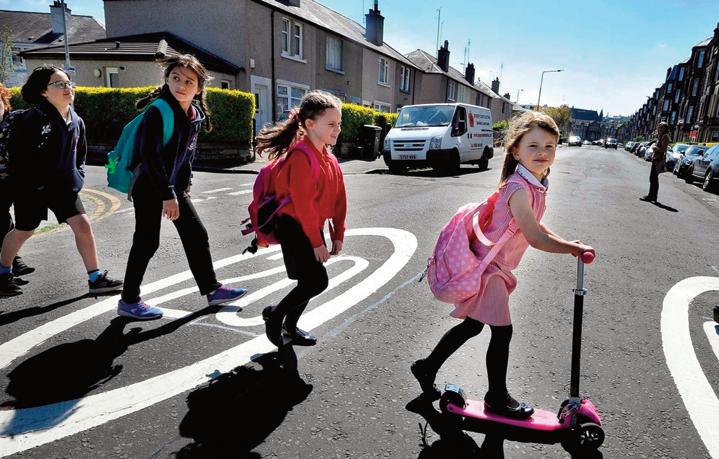

Landor LINKS is running a one-day event, hosted by Lambeth Council, to showcase best practice and offer practical guidance. This inaugural conference will bring together professionals from a range of disciplines.
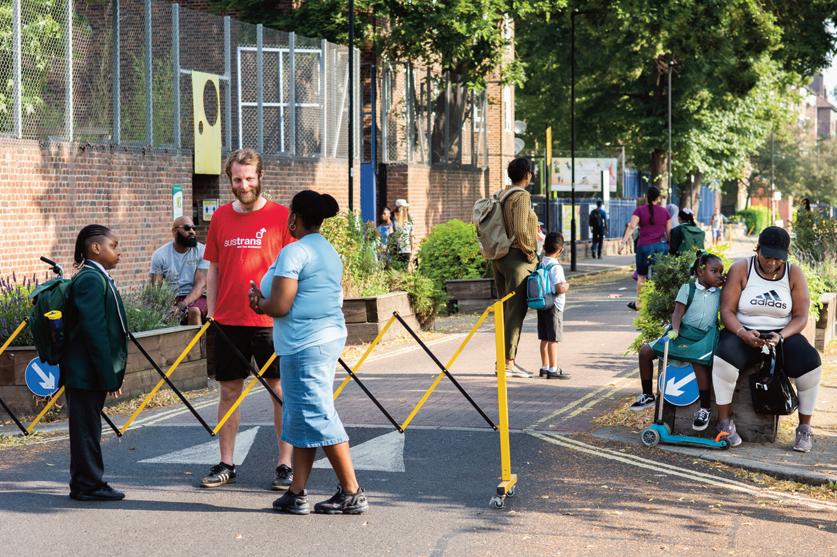
The panels will discuss issues including:
l Funding
l Partnerships
l Active travel
l Health and wellbeing
l Consultation and engagement
l Infrastructure design
l Monitoring
l Traffic management & enforcement

There will also be opportunities to hear case studies.
Speakers include:
Catherine Rose
Cabinet member for leisure, parks, streets and clean air, Southwark Council



Mete Coban
Cabinet member for environment & transport, Hackney Council
Louise Krupski
Cabinet member for environment & climate, Lewisham Council


Rob Shoebridge
Traffic and transportation group manager, Derby City Council

Jemima Hartshorn
Founder and director, Mums for Lungs

Tanya Braun
Director of Policy and Communications, Living Streets
Mahalia Sterling
Principal City Planner, Transport for London
Habib Khan

Founder and director, Meristem Design



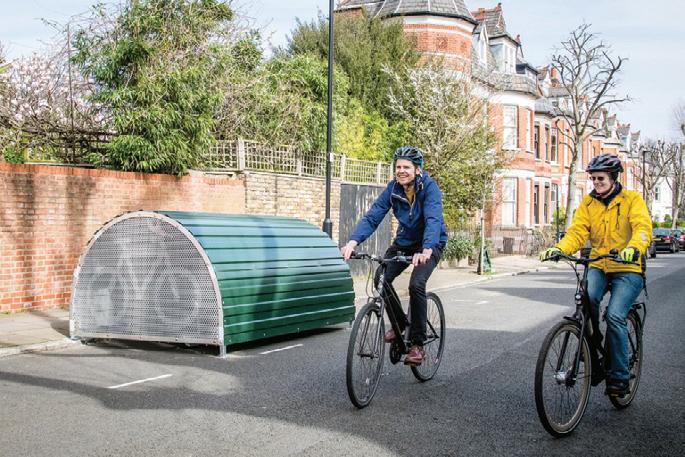
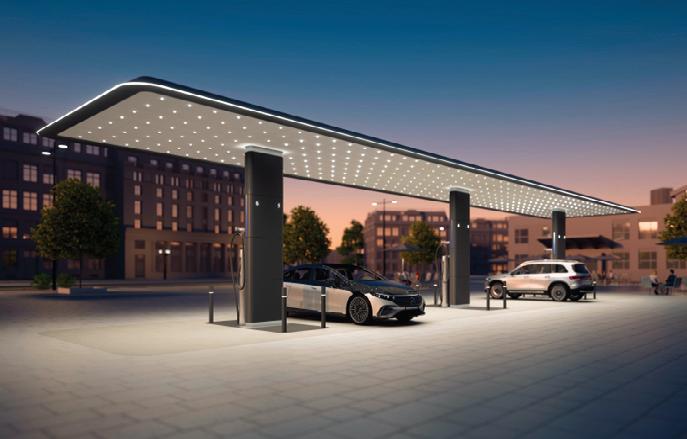




There have been significant falls in traffic on streets with low traffic neighbourhoods (LTNs) across London, with little sign of displacement to boundary roads, says a study by climate charity Possible and the University of Westminster’s Active Travel Academy. LTNs in London introduced between May 2020 and May 2021 have typically resulted in a “substantial relative reduction” in motor traffic inside the scheme area, with particularly strong reductions in inner London, the study says.
The mean average decrease in motor traffic on roads within LTNs (a reduction of 815 motor vehicles) was almost ten times higher than average increases in motor traffic on boundary roads (an increase of 82 motor vehicles), suggesting that LTNs are creating a substantial overall reduction in traffic, according to the report.
LTNs has resulted in many more streets experiencing under 1,000 motor vehicles passing through them a day, “implying that there may be a qualitative change in the local environment that has meant an increase in walking and cycling”, says the study, which is called Changes in motor traffic inside London’s LTNs and on boundary roads
Analysis found that 47% of boundary roads saw a decrease in traffic and 53% saw an increase. Average motor traffic counts showed that on boundary roads, traffic changed “relatively little”
with a mean average increase of just 82 motor vehicles per day. This is less than 1% increase on the mean average of 11,000 vehicles that pass through boundary roads on a typical day.
Data from ‘pre’ and ‘post’ monitoring sites on boundary roads

were similar – around 11,000 motor vehicles per day, the study found. “The picture of little change on average in motor vehicle numbers on boundary roads is good news for the potential for exemptions to limit journey length and hence time increases for key users, if this is judged necessary,” the report states.
But the study reveals there are “substantial variations” in both increases and decreases in traffic on boundary roads, between individual LTN schemes. The study suggests that these variations are not likely to be primarily caused by LTNs “but could, instead, be caused by other contextual factors such as major local works or wider background trends”.
The report cites the rise in motor traffic in Newham, which “may well be due to Olympic legacy-related development, particularly increasing motor traffic on boundary roads”.

Asa Thomas, PhD researcher at the Active Travel Academy at the University of Westminster and lead author of the study, said: “This study finds that most streets within LTNs see reductions in most traffic, improving the experience of walking and cycling. Two-thirds of these now have vehicle flows below 1,000 vehicles a day, a rough threshold for a quiet pedestrian-friendly street, compared to only two-fifths before. What’s more, there is little indication of systematic displacement of this traffic to boundary roads.”
Prof Rachel Aldred, director of the Active Travel Academy at the University of Westminster and co-author of the study, said: “The research indicates there has been overall ‘traffic evaporation’ as a result of these schemes, as the mean average reduction in motor traffic on internal roads is around ten times higher than the mean average increase on boundary roads, adjusting for background trends. This suggests that not only do LTNs have substantial benefits inside their boundaries, but they can also contribute to wider traffic reduction goals.”
Since the start of the COVID-19 pandemic, low traffic neighbourhoods (LTNs) have been introduced in London, and to a lesser extent, other parts of England. LTNs are schemes that seek to reduce motor traffic in residential areas, using traffic management measures such as ‘modal filters’ that block through motor traffic while permitting walking and cycling.
Modal filters can be camera-enforced (in which case, permitted motor traffic such as emergency vehicles may be exempted) or physical, potentially with unlockable bollards, restricting access further. Sometimes measures such as short sections of opposed one-way streets are used to similar ends.
Newly introduced LTNs in London had within six months of the pandemic starting covered 4% of London’s population. Hence a local intervention was introduced across the city on a relatively large scale, although only by some boroughs, and the rate of introduction has slowed since then. However, the design principle has precedents. The London Borough of Waltham Forest had introduced similar schemes pre-2020 as part of its ‘mini-Holland’ programme, and other boroughs such as Hackney have examples dating back to the 1970s.
Smaller-scale examples, sometimes just single bollards or gates, exist across the UK and other countries as reactive measures to deal with specific local problems in one street.
Housing estates, both public and private, often use such design principles, seeking to stop drivers from cutting through such estates from one side to the other. In the Netherlands, the principle is known as ‘unbundling’ and refers to the goal of separating motor traffic from people walking and cycling, to prioritise and reduce risk to the latter.
Extract from Changes in motor traffic inside London’s LTNs and on boundary roads
Councils must act to improve conditions on boundary roads around LTNs, a study by climate charity Possible and the University of Westminster’s Active Travel Academy concludes. This could involve increasing the number of bus lanes and public transport provision, urban greenery, widening pavements, and protected cycle lanes as well as expanding low emission zones.
It is “highly likely” that boundary roads will remain polluted, unsafe, or difficult to cross or cycle on, the report warns.
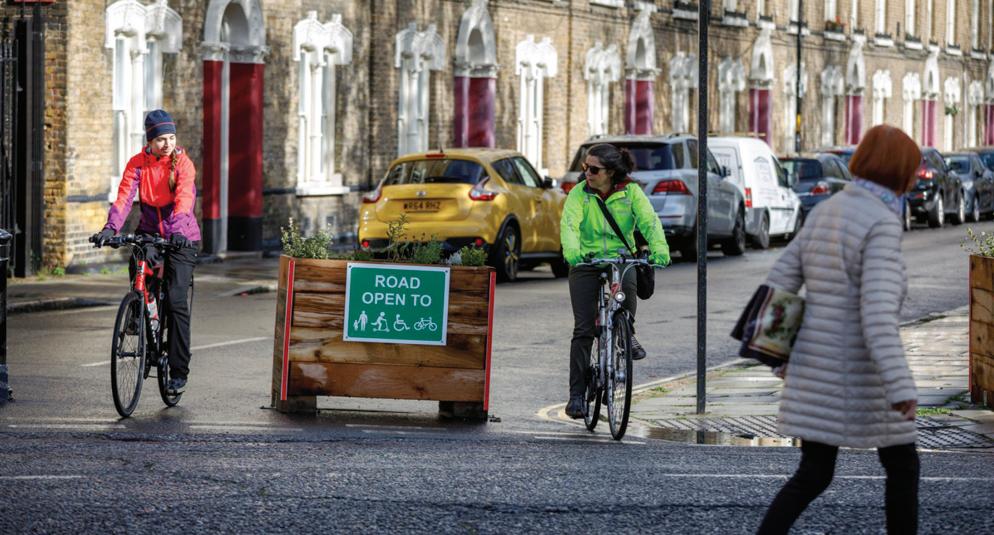

“Removing LTNs is unlikely to alleviate these issues so it is vital for local authorities to consider other measures that could. For instance, expanding low emission zones, road user charging, increasing the number of bus lanes and public transport provision, urban greenery, widening pavements, and protected cycle lanes could all make a contribution.”
Hirra Khan Adeogun, head of Possible, said: “This report shows that low traffic neighbourhoods are having a verifiable, positive impact for the people living on these streets. But, importantly, it shows that they have no consistent impact on boundary roads. In a climate crisis, we need our policymakers to make bold, data-led decisions; this report gives them that information. What we need now is action to drive down traffic, make our cities happier and healthier, and directly address the climate crisis.”
Low traffic neighbourhoods (LTNs) reduce traffic and air pollution without displacing the problem to nearby streets, new research has shown. The study by researchers at Imperial College London looked at three LTNs in London, to identify their impact on both air pollution and traffic within the LTN zones and in the surrounding area. LTNs aim to reduce through traffic in residential areas, usually by the use of barriers which prevent cars from using certain streets, while leaving them open to pedestrians and cyclists.
Many LTNs were put in place during 2020 to prevent an increase in vehicle traffic as people avoided public transport through fear of infection. However, they also provoked opposition, with critics claiming that LTNs increased traffic and pollution in surrounding areas. The researchers studied three LTNs in Islington, one of London’s most densely populated boroughs, which were put in place during 2020. The team compared pollution and traffic levels at monitoring stations inside the zones, on streets surrounding the zones, and at control sites further away, using data gathered by Islington Borough Council. The LTNs – in St Peter’s, Canonbury and Clerkenwell – were put in place between July and September 2020. The team analysed data gathered from July 2019 to February 2021.
Because each of the LTNs was set up at a different time and not all monitoring sites gathered data continuously, averaging out the results between the three LTNs would not provide an accurate overall picture. So the team carried out a more complex statistical analysis to ensure other factors that might affect traffic volumes and air pollution at particular times – such as the COVID restrictions in place, school holidays or weather – could be taken into account.
Using this analysis, the researchers found that concentrations of nitrogen dioxide fell by 5.7% within the LTNs and by just under nine percent on their boundaries, compared to the control sites. They also found that traffic dropped by over half inside the LTNs and by 13% at the boundaries, compared to the controls.
Dr Audrey de Nazelle, from Imperial’s Centre for Environmental Policy, said: “This research effectively disproves the argument that low-traffic zones will necessarily cause an increase in traffic and air pollution in neighbouring streets. In the three areas we looked at, they reduced both traffic volumes and, significantly, air pollution both inside and on the edges of the zone. Alongside the other benefits of LTNs that have been shown in previous research – such as improvements in safety and an increase in walking and cycling –this makes a very strong argument in their favour.”
Co-author, Imperial College London PhD student Xiuleng Yang, added: “This is the first study to use a robust statistical approach to show the impact of LTNs on surrounding areas, and the results are really encouraging. We worked with a relatively small data set and further research is now needed to confirm these findings at a larger scale.”
Evaluation of low traffic neighbourhood (LTN) impacts on NO2 and traffic by Xiuleng Yang, Emma McCoy, Katherine Hough and Dr Audrey de Nazelle is published in Transportation Research Part D.
Islington Council’s people-friendly streets programme aims to make the London borough accessible to all, reports Deniz
HuseyinIslington Council has announced plans to continue the roll-out of its people-friendly streets programme. The plans include implementing more School Streets at primary schools on main roads and at secondary schools across the north London boroughgh. Islington will also create more Liveable Neighbourhoods, more cycleways and the development of public realm schemes such as Clerkenwell Green.

Liveable Neighbourhood (LN) schemes will be subject to “extensive engagement and consultation” before they are introduced from 2023/24 onwards, the council stressed. Schemes are set to be introduced in Mildmay East, followed by The Cally, Barnsbury & Laycock, Annette Road, and Highbury New Park.
Across the borough there are currently 35 School Streets, covering 88% of eligible primary schools, seven low traffic neighbourhoods covering 24% of the borough and three pop-up cycleways, the council reports. “The intention behind the schemes is to reduce traffic through School Streets during key hours, and through the LNs (and low traffic neighbourhoods, LTNs) during all hours,” the council said. “This reduction in traffic volumes (as already evidenced in the monitoring reports) will improve air quality outside schools and in LNs (and LTNs) by reducing harmful emissions like NOx and PM10s and will also encourage residents and commuters to walk and cycle more by creating a lower traffic environment.”
The delivery of cycleways, including pop-up cycle lanes, also helps encourage and enable more people to cycle by providing dedicated and largely segregated facilities, the council adds. It says: “In some cases – such as where parents stop driving their children to and from school, or residents choose not to drive for short trips, or traffic “evaporates” due to the new restrictions –this will reduce traffic, emissions and congestion.”
However, there may also be cases where motorists take longer routes, leading to additional emissions and congestion elsewhere, including on boundary roads of LTNs, the council acknowledges. The council said: “On balance, it is expected that the overall emissions (including carbon emissions) and congestion will reduce on the roads within the schemes, and surrounding areas, as more residents and others are encouraged to travel by sustainable
means of transport. It is important to note that any reductions in traffic volumes and emissions should be compared not just to the pre-pandemic situation, but also to models which showed that in the absence of action, private motor vehicle journeys could have nearly doubled.”
The council is planning to introduce a new cycle route linking Regents Canal and Highgate, and is working with Transport for London on creating Cycleway 50, connecting Camden and Tottenham Hale.
Since October 2021, the whole of Islington is inside the expanded Ultra Low Emission Zone (ULEZ), which should reduce emissions on the borough’s roads, the council predicts. Liveable Neighbourhoods in the borough will involve a range of improvements such as additional green spaces, improved pavements and public realm improvements. The council said: “By implementing these changes and restricting through traffic, the people-friendly streets programme will continue to reduce road danger, improve accessibility and make it easier to walk, wheel and cycle. The measures should also reduce the negative impacts of traffic, improve air quality, and reduce injuries from road traffic collisions.”
Islington Council is to allow disabled people to drive through camera-enforced traffic filters in the borough without being fined. “People who, due to a disability or chronic health condition, experience considerable physical difficulty or overwhelming psychological distress when extending or rerouting car trips can apply for an Individual Exemption,” said the north London borough.
The exemption will allow disabled people to drive through the borough’s people-friendly neighbourhoods. Applicants do not need to have a Blue Badge, or live in a people-friendly streets neighbourhood.
The council has so far introduced seven people-friendly streets neighbourhoods, designed to make it easier to walk, cycle, scoot, and use buggies and wheelchairs.
Traffic fell within all of the neighbourhoods within their first 12 months, and air quality improved in each neighbourhood and on surrounding boundary roads between 2019 and 2021, said the council. But the council said it had taken on board feedback regard the needs of disabled people who were dependent on cars.


Lambeth Council has pledged to significantly cut on-street parking as it seeks to meet its net zero target by 2030. Taking out parking space would encourage active travel, create people-friendly places and increase climate resilience, says the new Lambeth Kerbside Strategy.
Currently, 94% of kerb space in the borough is allocated to parked vehicles, the south London council estimates.
Under the £31.7m strategy, 25% of kerb space would transfer to”sustainable uses such as bus lanes, street trees, sustainable drainage systems (SuDS), parklets and cycle parking. Some of this space would also be set aside for car clubs and disabled bays. More space will be given over to new bus lanes, states the strategy.
Lewisham Council is to replace parking spaces with trees, electric vehicle (EV) charging points, cycle storage, and safer crossings and junctions. More car club and disabled bays will also be installed across the south London borough.
The council said the first phase of its Sustainable Streets programme will focus on the roads around Deptford and Catford, with changes due to start next summer.
Better use of pavements and road space will improve local streets and road safety, reduce noise, traffic, and air pollution, and help more people walk, cycle and use public transport, the council states.
Around 60% of road space in Lewisham is used for on-street parking, but less than half of households in the borough own a car, according to the council. The council said: “This is a huge amount of space that can be transformed to deliver better footways, more secure cycle storage, EV charging points, trees and planting and create spaces for the community to enjoy.
“Lewisham has more unrestricted street parking than any other inner London borough. The proposed improvements aim to make better use of this space in order to prioritise active travel, create safer streets for residents and help make Lewisham a net-zero borough by 2030.”
Reducing parking spaces will help encourage modal shift, the council said. It has set the target for 80% of all journeys in Lewisham to be made by walking, cycling or public transport by 2041. Alongside this, a new parking permit scheme will be introduced for residents and businesses. This will ensure parking is “prioritised for local people and businesses, as well as reducing unnecessary car journeys and encouraging more people to walk, cycle or use public transport”, said the council.
The permit scheme will also discourage people from using parking spaces near local shops and high streets for nonshopping purposes, “making it easier for other residents to visit local shops and high streets”.
Phase one proposals for Deptford and Catford will include a new secure cycle storage for nearly 500 bikes, over 300 additional street trees and almost 100 electric vehicle charging points.
If parking permit schemes are introduced in these areas, residents and businesses will be entitled to a 15% discount on their annual permit for the first year, said the council.
Cllr Louise Krupski, cabinet member for environment and climate action, said: “We want to reimagine our borough’s roads and streets to create a greener Lewisham, improve road safety and help reduce air pollution. Our Sustainable Streets programme is just the start of our ambition to increase active travel and reduce unnecessary car journeys, as we look to create a net zero borough and tackle the climate emergency.”
Residents and businesses in the areas covered by the first phase of the programme are being encouraged to share their views on the proposals. The consultation is open until Sunday 5 March 2023.
The council says cutting parking spaces will result in fairer and more equal access, community interaction, economic resilience, health and wellbeing. The council has set itself the target of cutting motor traffic by 27% in order to achieve net zero by 2030.
The Lambeth Kerbside Strategy comprises four priorities:
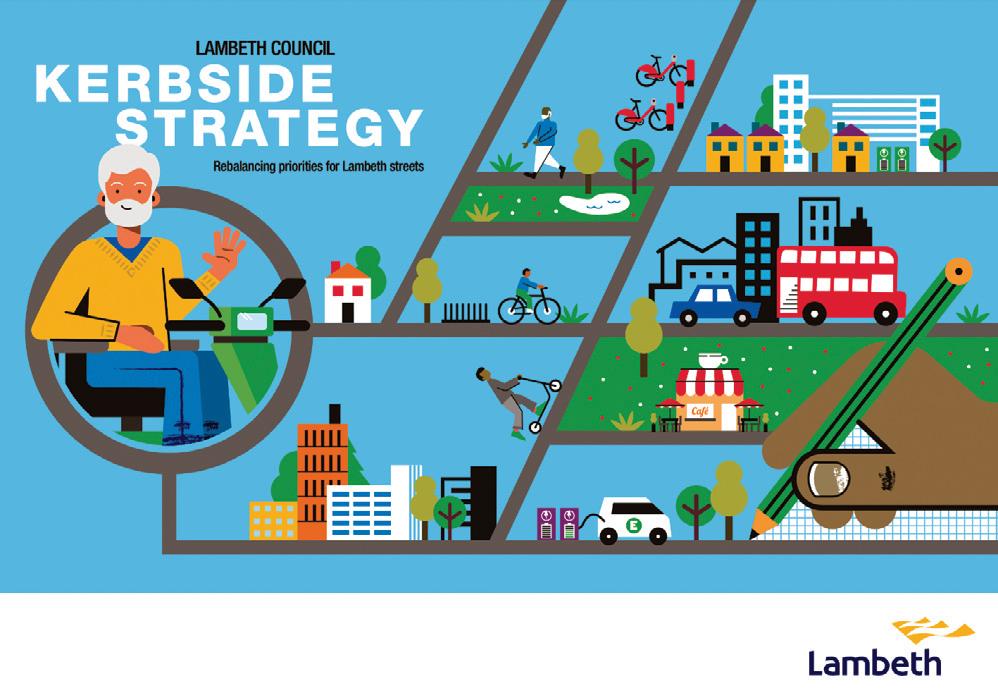
• Enable accessible and active travel: This would involve making pavements clear and accessible, particularly for people with mobility or sensory impairments. This includes minimum commitments for cycle parking and shared bikes, and high-quality walking networks. All households would be within 50m of free cycle parking.
• Create places for people: The council says many households do not have outdoor space or a car and cannot make use of the kerbside. Under the strategy, local people will be able to apply to use the kerbside for things like small community gardens. Businesses will be able to apply to use the kerbside for outdoor seating.

• Increase climate resilience: The strategy pledges that all streets will have shade from trees and green spaces or other biodiversity that together help protect us from these risks. There will be street trees every 25-metres on every street in Lambeth.
• Reduce emissions and traffic: The council predicts its targets for sustainable transport and traffic reduction will result in far fewer motor vehicles on the borough’s streets.
The council’s breakdown of the kerbside reveals that 46% of kerbside was for parking, 24% had yellow lines, 15% single yellow lines while 9% was taken up by driveways. This left just 6% for other uses.
Lambeth is planning to introduce more controlled parking zones (CPZs) across the borough. Currently there are large areas of the borough where there is very little regulation of kerbside uses.
The borough has 332 cycle hangars, each holding six bikes, but more are needed as there is a waiting list of more than 5,000 people, the council pointed out. Space will be allocated on the kerbside for dockless scooters and bikes to stop them being left on pavements. Cargo bikes will also need kerbside space, with shared cargo bikes available on the kerbside within every neighbourhood across Lambeth, and no more than five minutes’ walk of all households. Under the plans, all local high streets would have access to a shared electric van.
Easing of COVID restrictions sees councils issue 25% more disabled parking permits, says Department for Transport
Over 1 million Blue Badges were issued in the year ending March 2022, an increase of 25.7% on the previous year, new data reveals.
Disability, accessibility and Blue Badge statistics: 2021 to 2022 reveals that at 31 March 2022 some 2.44 million Blue Badges were held, an increase of 3.6% since March 2021. This means 4.3% of the population now hold a Blue Badge.

Between 1 April 2021 and 31 March 2022 1.04 million badges were issued, an increase of 212,000 badges (25.7%) on the previous year. This increase is likely to be at least in part due to the effects of the gradual easing of coronavirus (COVID-19) restrictions on local authority processes and staffing. Some 42% of these were issued without further assessment.
In England, 6,183 badges in the year ending March 2022 were reported to be lost or stolen. Of these, 76% were reported to be lost, and 24% were stolen.
However, the government is not collecting details of local authority prosecutions for the misuse of Blue Badges on the grounds that this is a time-consuming task.
The number of badges issued includes both new badges, and renewals of existing badges (which usually last three years).
Of the badges issued, 2.5% (26,000 badges) were issued under the new eligibility criteria for people with non-visible disabilities (introduced in August 2019). This is higher than in the year ending March 2021, when 2.2% (18,000) of all badges issued were for people with non-visible disabilities.
Out of the 1.04 million Blue Badges issued in the year ending March 2022, 593,000 (57%) were subject to further assessment, 436,000 (42%) were issued without further assessment and 7,000 (1%) were issued to organisations.
Out of the badges issued without further assessment, 94% were issued to those who met the relevant criteria under Disability Living Allowance (DLA) or Personal Independence Payment (PIP). The remaining badges were issued to those registered blind (5%) and those on War Pensioner’s Mobility Supplement or Armed Forces and Reserved Forces Compensation scheme (1%).
There were 2.44 million valid Blue Badges held as at 31 March 2022, an increase of 3.6% (84,000 badges) when compared with the previous year. This is similar to levels seen in March 2020. Of the badges held, 2.6% of all badges (64,000) were held by people with non-visible disabilities. This was an increase from 1.7% (39,000) in the
In England, 6,183 badges in the year ending March 2022 were reported to be lost or stolen. Of these, 76% were reported to be lost, and 24% were stolen.
In previous years Blue Badge statistics have included data on the number of people prosecuted for misuse of Blue Badges. The Department for Transport (DfT) states that in order to reduce the burden on local authorities and the department, the data have not been collected for the year ending 31 March 2022.
The DfT states: “There have been issues with the completeness and quality of these data in previous years, which in turn reduced their value to users. We would welcome feedback on this decision. We are now providing our statistics releases in HTML format. As part of making this change to the release, we have also made some other changes to the format and content of the release.”
year ending 31 March 2021.

On 31 March 2022 4.3% of the population in England held a valid Blue Badge, up slightly from 4.2% the previous year.
As at 31 March 2022, 2.43 million people (4.3% of the population in England) were entitled to a Blue Badge without further assessment (previously known as automatically entitled).
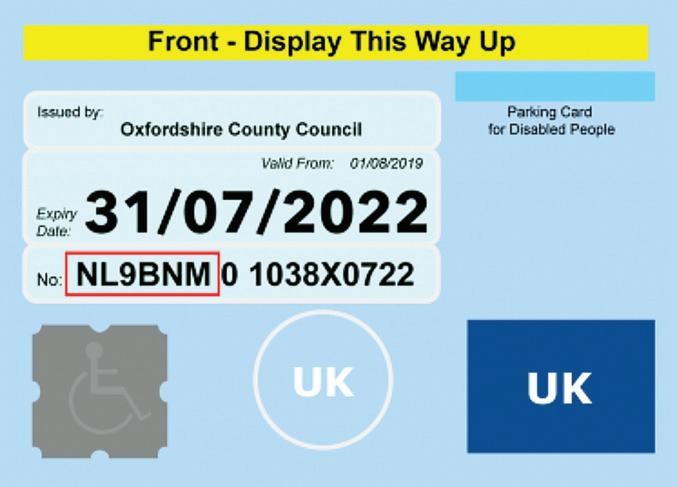
The number and proportion of people automatically eligible for a Blue Badge has been rising since 2015.
Out of the 2.43 million people who were eligible for a Blue Badge without further assessment, 41% held a Blue Badge. This shows a decreasing trend over recent years – the equivalent figure was 60% in 2015.
The region with the most Blue Badge holders as a proportion of their population was North East (5.1%). The region with the lowest proportion was London (2.9%), which also had the lowest regional proportion of retired people. Similarly, metropolitan areas such as Birmingham (3.5%) and Manchester (3.1%) also had comparatively low proportions of Blue Badge holders.
Data on the number of Blue Badges held refers to the situation as at 31 March 2022. Statistics on parking badges for disabled people in England are obtained from the Blue Badge Digital Service (BBDS) database Disability, accessibility and Blue Badge statistics: 2021 to 2022
Blue Badges are issued by local authorities to help people with mobility issues park closer to the goods and services they need to use. In August 2019 Blue Badge scheme eligibility criteria were extended to include more people with non-visible and neurological disabilities that may affect their ability to access goods and services. Blue Badges are issued according to need of the applicant and are not related to any specific condition. Anyone may be awarded a Blue Badge if they meet the scheme’s eligibility criteria. Badges can also be issued to organisations who transport people with disabilities. Upon issue, a Blue Badge is valid for a period of up to three years.

The Disabled Drivers Association of Ireland (DDAI) has called on the Irish government to change legislation to allow Gardaí and traffic wardens to issue penalties to drivers who illegally park in accessible bays in private car parks such as shopping centres, educational institutions, and hospitals.
The DDAI made the call when launching its Bay Watch campaign, which aims to highlight the ongoing abuse of disabled parking bays.
A nationally representative survey by Coyne Research, carried out in tandem with the DDAI’s own member research, underscored the lack of knowledge about the existing legislation around private car parks.
The Coyne Research revealed that, contrary to the existing position, 42% of those surveyed believed that a traffic warden or a Garda can issue a parking fine
to someone parked in a disabled parking bay in a private car park. Some 45% said they did not know.
Seven in 10 of people surveyed said those who illegally park in disabled bays should face prosecution, not just fines.
The separate survey of 800 DDAI members revealed that one third (33%) were unaware that Gardaí do not have the powers to impose fines on illegal parking in private bays, while 95% said those who illegally parked in accessible bays should face prosecution.
Hartlepool Borough Council has stopped charging disabled drivers for parking on streets after discovering it was breaching the law. The council said on-street parking was included in error when permitted charges were introduced in its car parks in April. The authority was alerted to the error by Labour councillor Ben Clayton. While badge holders are exempted paying to park in onstreet bays they can be charged in car parks.
Richard Ryder, DDAI communications manager, said: “Our Bay Watch campaign has been launched to tackle the anomaly in the current legislation whereby those parking illegally in accessible bays in private car parks are allowed to get away with it.
“It should not be left solely to the private car park owners to manage the problem. Our research has shown that such a move has the backing of the public who also support the prosecution of illegal parkers, not just the handing out of fines.”
A council spokesperson said: “It appears that when the decision to charge Blue Badge holders in council-owned off-street car parks was made last year, officers were under the impression that the decision to charge applied to all Blue Badge parking. This resulted in the parking meter signage being changed on all meters rather than just the off-street parking meters.” There are about 6,000 Blue Badge holders in Hartlepool. None were issued with a penalty charge as a result of the error.

Our online portal offers after sales support regarding machine maintenance and repairs for all our customers.
Using a unique log-in, customers can log faults using specific machine numbers, follow a series of trouble-shoot checks, before provisionally booking a preferred date for a regional field engineer to assess the machine.
▪ Allows customer to follow a series of checks before booking in repairs.
▪ Alert’s customer when engineer is 15 minutes from site.
▪ Gives the customer & IPS Group UK access to historical call data.
▪ FULL training available.
New cycle parking to enable more children to ride their bikes to school and store them safely have been opened by Greater Manchester’s active travel commissioner Dame Sarah Storey.

Arlies Primary School and Silver Springs Primary Academy in Stalybridge had the cycling stores installed after receiving grants from Transport for Greater Manchester (TfGM).
Each cycle store provides young cyclists with stands to secure their bikes to under a large shelter, ensuring that their bikes are safe and dry while they learn at school. Teachers and school staff can also use the stores.
Dame Sarah, a Paralympic cycling and swimming champion, was appointed as active travel commissioner last year.
Home to school travel is one of the commissioner’s priorities in her Refreshed Active Travel Mission for the city region. She wants to ensure schools have the tools to support youngsters in participating in active travel. It also forms a key component in the delivery of a fully integrated transport system for Greater
Manchester called the Bee Network.
Dame Sarah delivered talks at both schools to inspire and enlighten youngsters about the benefits of walking, wheeling and cycling to school.
She said: “It was great fun to meet pupils and staff at Arlies and Silver Springs and officially open their new cycle stores. Their enthusiasm for walking, wheeling and cycling was infectious, but I heard that it hasn’t always been easy to make active journeys to school.
“It’s noticeable how these new facilities are already supporting more active journeys. I really hope these excellent facilities con-
tinue to be well used and lead to more children, teachers and school staff walking or cycling to school. Everyone agreed it is great to get moving in the fresh air before and after the school day and has the added benefit of reducing traffic congestion in the local area.”
Arlies Primary and Silver Springs are two of 10 schools in Tameside and 62 in Greater Manchester to be awarded funding for cycle stores. A shelter and five Sheffield stands were installed at Arlies. At Silver Springs a new shelter was built to cover existing stands and stands added at a new location.
Silver Springs has been
A School Street has opened in Bury to help keep pupils safe and encourage them to walk or cycle to school. A traffic-free environment now exists outside Guardian Angels Primary School during peak times in the morning and afternoon.

The initiative is a partnership between the school, Bury Council, Living Streets and Transport for Greater Manchester. A second Bury school, Chesham Primary, has also agreed to implement a School Street at a date to be confirmed later this year.
School Street schemes close the road to certain vehicles for short periods during peak drop-off and pick-up times – 8am8.45am and 2.15pm-3.30pm. Marshals put out signs, cones and barriers to stop nonresidents driving through the area. School Streets still allow residents and businesses on the street to use the road if they drive at a walking pace and show a valid permit.
Cllr Alan Quinn, cabinet member for the environment, climate change and operations, said: “School Streets cut traffic and congestion outside schools, which will help to keep our children safe. The air quality will also improve thanks to the reduction in engines idling during busy drop-off and pick-up times.”
The Guardian Angels scheme is backed
by Greater Manchester’s Active Travel Commissioner Dame Sarah Storey. In November, she unveiled Refreshing Greater Manchester’s Active Travel Mission, which highlights the benefits of active travel and why it is fundamental to the success of other key agendas for Greater Manchester, including a ‘vision zero’ recommendation for road danger reduction.
Dame Sarah said: “A School Street’s main function is to improve the safety of children as they head to and go home from school. With vision zero a key recommendation within my recent Refresh mission report, local interventions like this make a significant contribution to reducing road danger. Whether it’s pavement parking, struggling to cross the road due to the
involved in several events along the first Bee Network scheme to open in Tameside.
Pupils have taken part in two story walks, a ‘jog, walk or wheel’ event and a festive ‘Jingle Jog’, enjoying the fresh air and exercise along the scenic walking and cycling route. These were facilitated and supported by Tameside Council, TfGM and Ridgehill Big Local Enterprises, a not-for-profit social enterprise that leases and manages Chadwick Dam to benefit the community. Pupils can use the new network to make sustainable journeys to and from school or to access the natural scenery.
Deborah Mason, principal of Silver Springs, said: “We are committed to enriching our children’s education with wider opportunities in sport and promoting healthy lifestyles. The children really enjoyed the opportunity to hear about her role as active travel commissioner and were inspired by her responses to their questions about her sporting career and future plans.”
Cllr Gerald Cooney, Tameside Council executive leader, said: “These fantastic new cycle stores will be of great benefit to pupils and staff who are able to take the healthy and sustainable option of cycling to school.”
volume of vehicle traffic or speeding drivers, many parents tell me it just doesn’t feel safe to head to school on foot or allow older children to go alone.
“It’s great to see that Bury are trialling this School Street, with the park & stride locations still facilitating those who live outside walking distance of their school or who need to drive somewhere else after dropping off. Resident access is unaffected by these measures and in other areas School Street measures are welcomed by residents who are often affected by people blocking their normal access route.”
Guardian Angels Primary School takes part in WOW, the walk to school challenge from Living Streets. Since starting WOW this academic year, Guardian Angels Primary School active journey rates have increased by 15%. Dan O’Connell, project coordinator at Living Streets, said: “We’re thoroughly enjoying working with Guardian Angels Primary School to run WOW and promote the health, social and environmental benefits that come from walking to school. Unsafe speeds, pavement parking and road danger can put families off walking to school. This new School Street will remove those barriers, making it easier, safer and more attractive for even more pupils and their families to choose to walk.”
WPS is a leading solution provider of pay on foot systems and we have teamed up with industry payment providers to give motorists the same experience in paying for parking on-street in the off-street environment.
Digital payments, pre-booking and permit systems are ready to go using our partners JustPark, ZatPark and now with the addition of RingGo, or using our own payment app, WPS Pay.
You can be confident when investing in WPS that you are providing your customers with the widest choice of payment options coupled with an industry-leading redesigned user interface.
WPS are also proud to be leading the way with confirmed integration into the new National Parking Platform (NPP).
Build your parking operation on the WPS Parking Platform and our ever-growing Marketplace of integrated solutions.


An East Anglian council has lost an appeal over how it treats VAT on charges drivers for parking.
Off-street car park terminals provided by the Borough Council of King’s Lynn and West Norfolk do not give change if customers overpay for a tariff.
As a result, this means that some drivers who do not have the right coins to hand pay more to park than the prescribed charges. The council argued these overpayments were not taxable because customers could contact it to recover the overspend.
A five-year legal battle with His Majesty’s Revenue and Customs (HMRC) has focussed over whether the council should pay VAT on the difference. The First Tier Tribunal originally ruled in January 2021 that the council should pay VAT. The Upper Tribunal at the Royal Courts has now agreed that these customer overpayments should be subject to VAT.

The council earns around £4m a year from the 29 sites it runs in towns such Burnham Market,
Leeds City Council plans to introduce parking fees at a range of green spaces and leisure locations as the Labour-led council seeks to fill a £15m budget gap.
Parking fees will be introduced at 30 parks under the plans. Charges starting from 40p an hour will be collected via a phone app.
Free parking will come to an end at locations such as Golden Acre Park, Middleton Park, Kirkstall Abbey, Otley Chevin, Roundhay Park and Temple Newsam.
Visitors at 24 other public venues around the city will also be charged for parking under the plans.
Money raised from the charges would help fund maintenance of the car parks themselves, the council said.
Blue Badge holders would be exempt and season tickets could be introduced at parks for frequent visitors.
Heacham, Hunstanton and King’s Lynn. The tariff for an hour’s parking at one of the sites was £1.40, but if a customer paid £1.50, they would not have received 10p change from the ticket machine.
HMRC said by making the overpayment of 10p, the customer was making “a counteroffer” to pay £1.50 to park for one hour, which was then accepted by the machine on behalf of the council.
The council argued it should not have to pay VAT on the extra 10p, because the customer could in theory claim it back.
Mr Justice Miles and Judge Greenbank considered the case of a driver who paid £1.50 instead of an hourly change of £1.40 because they only had a pound coin and a 50p piece to put into the machine.
Their judgement said: “There is a direct link between the entire £1.50 and the supply of parking with the result that 10p ‘overpayment’ should be treated as consideration for the supply of parking services and therefore subject to VAT.”
The judges concluded: “For VAT purposes, the overpayments are part of the consideration for


the provision of off-street parking by the council.”
An HMRC spokesperson said: “HMRC welcomes this ruling which clarifies that VAT is liable to local authorities when customers overpay on their offstreet car parking charges.”
The council said in a statement: “This has been a longrunning case, in which the courts have previously upheld the council’s position. This appeal was brought by the council as a test case, in order to clarify an important legal principle that concerns a number of local authorities nationwide.
“The council has not incurred any legal costs in making this appeal and, because the council has been paying the VAT pending the outcome of this case, this decision has no new financial consequences for taxpayers or the council.
“The council welcomes the certainty that the court’s decision now brings to an important area of VAT law for public bodies.”
Neither the amount of money the council pays in VAT or the amount of this which comes from people who pay more because they do not have the right change was revealed in court.
residents through the cost-of-living crisis, as well as tackling the climate emergency.
“This policy supports both our net carbon zero 2030 ambition and our Clean Air Neighbourhoods programme. The new banding will encourage the transition to electric and low emission vehicles. And it will maintain the policy targeted at nonresidents who want to use the borough as a cheap car park.”
The London Borough of Hammersmith and Fulham is to cut its parking charges in order to support residents in cost-of-living crisis. Most drivers will see the hourly rate to park in the west London borough reduced from £5 an hour to £3.50 an hour.
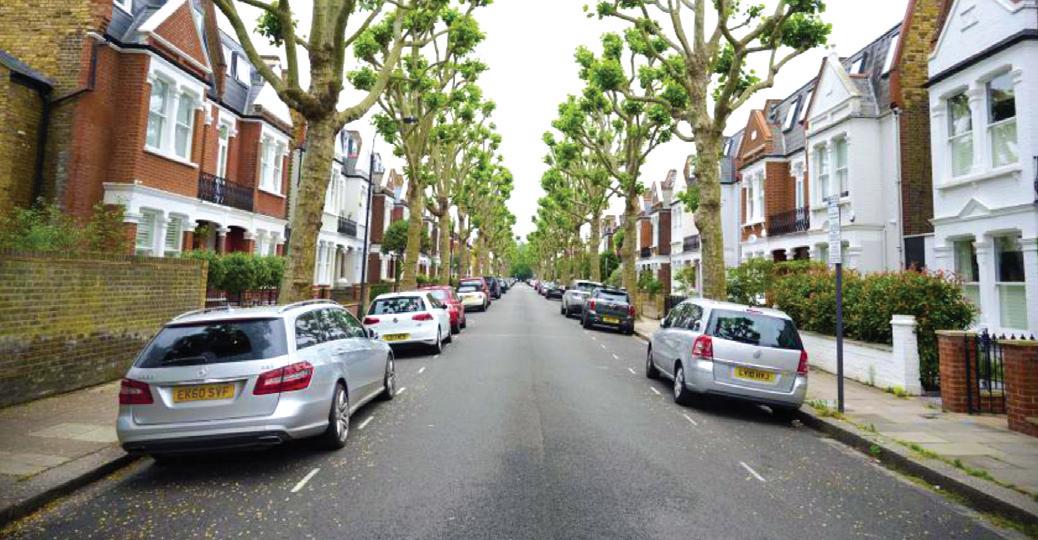
Electric vehicles will be charged a reduced fee of £2.50 per hour as part of new charging bands based on vehicle emissions.
In total, 80% of vehicles will see a decrease in charges with only the highest polluting vehicles paying more.
Since 2014, the council said it has kept parking charges well below the rate of inflation.
Cllr Sharon Holder, cabinet member for the public realm, said the cut in charges would help families faced with inflation at 11%, food inflation at 13% and energy bills typically averaging £3,000 per household.
“We have listened and responded to residents who asked us to support them during the cost-of-living crisis. We are introducing new parking charge bands based on vehicle emissions. We are supporting
A report detailing the new charges was agreed by Hammersmith and Fulham’s cabinet on 9 January.
The reduced charges are also designed to support local businesses by making it cheaper for residents who need to drive to do their shopping. Extra 20p shopper parking bays have also been introduced.
The new emission bands will be implemented following a period of consultation. Pay & display tariffs will remain un-changed so residents are encouraged to use the mobile parking app RingGo to take advantage of the lower charges.
APCOA Parking is championing the concept of enhancing the range of services at car parks so they become mobility hubs.

The company plans to launch 10 hubs arounds the UK, with each location tailored to serve the needs of their local communities. The first mobility hub will be opened at St Catherine’s Walk in Carmarthen, Wales, scheduled in February.
Sites in Manchester and Sheffield are next in line for the ‘Urban Mobility Hub’ refurbishment, with a further seven sites identified for transformation.
Through working with network of partner organisations, APCOA ‘Urban Mobility Hubs’ will be equipped to offer a range of services focussed on the needs of the local community at each location. These services will

include electric vehicle (EV) and electric bike charging points, both fast and rapid.

Charging will be facilitated by automatic number plate recognition (ANPR) technology and linked to a range payment options including autopay, prebooking, apps and late payment.
APCOA’s hubs will also feature vendor lockers designed to eliminate the need for emissionheavy multiple location courier drops. Other facilities include Wi-Fi enabled office pods and spaces for remote working, complete with vending machines for drinks and snacks.
Energy-efficient LED lighting will illuminate a range of parking bay types dedicated to specific user groups: Blue Badge holders, parent and child parking, motorcycles, EV and allocated prebookable premium bays.
APCOA is working with partners to design and install roofbased solar panel systems that will power each site. It is also
working to maximise last-mile delivery hub potential and introduce further opportunities at all future locations.
Customised services reflecting the needs of the local community will be on offer in each hub, with car rental, emissions-based tariffs or screens providing live data on local train, bus, taxi and events information for example.
There are also opportunities for local businesses to utilise the hubs’ infrastructure and footfall to their advantage by working with APCOA to create popup shops and kiosks or to use parking bays for other services.
The hubs form part of APCOA’s wider environmental, social and governance (ESG) strategy, which will also see the delivery a 10,000 on-street and off-street electric vehicle chargepoints in the UK by 2025. The ESG strategy sets a company target of net zero carbon by 2040.
Deliveroo riders have agreed to stop parking on an Essex high street.
Brentwood Borough Council said the town had a problem with vehicles parking illegally on pavements, with takeaway food couriers being a particular nuisance.
Deliveroo has worked with the council on the new arrangements that see its riders allowed 15 minutes of free parking in bays on other streets. Deliveroo riders would have a parking badge which would stop them getting onthe-spot parking fines in the allocated bays.
Council leader Chris Hossack said: “There is no denying that
most High Streets across the UK have kind of turned into big drive-thrus – whether they be for pizzas or Chinese takeaways. But in order to help them we have allocated offstreet parking bays in Chatham Way and William Hunter Way where they can pull up and get 15 minutes grace.
“We are pioneering a system with Deliveroo. They haven’t done it with any other council yet. They are even sharing what we are doing in Brentwood with city councils like Cardiff and Edinburgh.”
The council’s discussions with Deliveroo came as Brentwood’s High Street saw more parking fines than any
other in Essex, with 3,333 penalty charge notices issued between 1 July 2021 and 30 June 2022, resulting in £80,571 being raised.
The council met with a team from Deliveroo’s head office and engaged with their riders.
A Deliveroo spokeswoman said: “The safety of Deliveroo riders and pedestrians is a priority, and we are pleased to be working with the local authority to launch a pilot parking scheme for Deliveroo riders. This will provide riders with parking guidance and grant them permission to park for free in permitted zones so they can safely collect customer’s orders.”
Kim Challis is regional managing director UK & Ireland and group ESG director at APCOA. She said: “Centrally located car parks already fulfil a vital primary purpose. but with an increasing scrutiny on the value of urban sites and an essential focus on sustainability, there is an opportunity for these prime sites to offer more value to the local community, make a contribution towards environmental targets and act as a blueprint for the future of car parks across the UK and beyond.
“Urban Mobility Hubs are undoubtedly the future of car parks and a convenient and practical centre point for communities committed to sustainability.
“With more than 1,600 car parks across the UK, there is enormous potential for APCOA to make a difference by working with landlords and partner organisations to create a network of Urban Mobility Hubs.”
E-scooter rental in Bristol will be revised so the machines are parked in special areas marked on the road rather than pavements.
Voi has operated rentable e-scooters as part of a trial in the city since October 2020.
Bristol City Council is now asking scooter operators to bid for a long-term contract. The new rental scheme, expected to begin in the spring or summer, is also set to include electric bicycles.
A cabinet report said: “It’s proposed to formalise rental parking hubs, bringing them under Bristol City Council control and physically marking the parking locations.”








The existing offence of obstruction of the road will be used to address the issue of pavement parking in Wales.
The Welsh Government has grown frustrated with a lack of action by the UK government, which has yet to progress changes to national regulations on obstruction of the road.
Deputy climate change minister Lee Waters has announced that a way to allow local authorities to act against pavement, or footway, parking has now been identified by a special taskforce.

The Welsh Government received a report from the Welsh Pavement Parking Taskforce on the issue in 2020. While the taskforce rejected an outright ban on pavement parking it recommended that councils be given additional powers to tackle problem areas.
The Welsh Government made a commitment to give local authorities the powers to tackle pavement parking by introducing subordinate legislation to allow civil enforcement.
The original plan was for the UK government to amend existing regulations on obstruction of the road so as to separate out obstruction of the pavement. While the UK government has
committed to this, it has not yet secured parliamentary time to take this forward.
With time unlikely to be found in the foreseeable future, the Welsh Government will therefore consult on the proposal to permit local authorities to enforce the unnecessary obstruction of the road as a parking contravention by way of civil enforcement. It is proposed that the police will also retain the ability to enforce the offence as a criminal matter, as well as the new civil enforcement powers by local authorities.
There is currently no specific offence of parking on pavements
at the current time. Police can enforce the existing criminal offence of causing “unnecessary obstruction of any part of the highway”, but this is rarely enforced.
Lee Waters, deputy minister for climate change, issued a statement: “In 2019, I set up the independent Wales Pavement Parking Taskforce (WPPT) to help tackle anti-social pavement parking in our communities. All ten of the Pavement Parking Taskforce’s recommendations were accepted by the Welsh Government.
“We committed to work with stakeholders to further develop
A driver was left feeling devastated after discovering that her car had been stripped for parts while she attended a concert in Birmingham. Rebecca Scotland parked her Citroen C1 in a Digbeth car park at 7.30pm on an evening in December while attending

a show at the O2 Academy.
On returning to her car at around 11.30pm she discovered the whole of the front exterior had been taken.”I’ve never seen anything like it. I’d say it was the worst night of my life,” the 27-year-old told
and refine the proposal to give local authorities the powers to tackle pavement parking by introducing subordinate legislation to allow civil enforcement. However, progress has been frustratingly slow.
“To achieve our aim, we need the UK government to amend existing regulations on obstruction of the road, expressly separating out obstruction of the pavement. The UK government have committed to this but have not yet secured parliamentary time to take this forward, nor is time likely to be found in the foreseeable future.
“I reconvened the Wales Pavement Parking Taskforce and asked them to explore other ways of achieving our policy aims. The taskforce examined the feasibility of using the existing offence of obstruction of the road to address the issue of pavement parking. This approach could deliver additional benefits, allowing local authorities in Wales to deal with both pavement parking and also parked vehicles obstructing our roads.
The Pavement Parking Taskforce has subsequently provided an addendum to their original report and recommended that this is the best way forward. I have accepted this recommendation and now propose to consult widely prior with a view to introducing the necessary legislation by the end of 2023.”
“I thought the car looked a bit funny, I thought it was the lighting. It turned out that the front exterior had been stripped from it. The bonnet, headlights, bumper and a smashed window as well, so they could get the bonnet open.
“It’s my first car, my baby, I think one of the reasons I’m so devastated is that I’m still paying for it till I’m 30 and I turn 28 next month,” she added.
Her car is now back on the road after an insurance claim. She told the BBC: “You’d think they’d be going for the more expensive cars but they seem to be just picking on what’s popular.”
The removal of catalytic converters from cars while they are parked is a growing problem, but the cannabalisation of a vehicle in a public car park takes the issue of parts theft to a new level.
In the final three months of last year West Midlands Police arrested more than 100 suspects in a crackdown on vehicle crime. The force is advising people to think twice about buying parts from unauthorised or non-trusted dealers.
Debt recovery company DCBL has appointed Nicola Clark as group operations manager.

Clark has held a senior business operations and customer service manager positions in the financial services sector over a 20-year career with companies such as Amber Financial Investigations and Paradigm Financial Advisers.
Darren Connor, managing director at DCBL said: “As we continue to grow after another great year, we wanted to further strengthen our senior management team so we can maintain our progress and put us in the best possible position for future growth. Nicola understood our values, demonstrated a clear understanding of what we want to achieve, and is a great fit with the rest of the team’s skills.
“Nicola’s passion shone through, and she stood out for us in every area. She was able to draw on her vast experience and demonstrate through previous roles that she was the right
person to help drive the business to the next stage.”
Clark said: “I take great pride in mentoring and ensuring staff are coached and developed to reach their full potential. I will work with the rest of the senior management team to develop a culture of continual improvement, that includes root cause analysis and implementing controls to prevent reoccurrence. It’s an exciting time to join the group and be part of the next phase of growth for the business.”
DCBL has also appointed a new chief financial officer. Carl Boardman is a CIMA-qualified

accountant who has worked in tech, facilities management and debt management companies during a 20 year career.
Boardman will be responsible for developing the group’s financial and accounting processes and reporting to the business’s stakeholders.
Boardman has previous experience of working with large high transactional businesses and has a history of upskilling teams to maximise efficiencies and aid growth.
Darren Connor, managing director at DCBL said: “After another successful 12 months of trading we have decided to
strengthen the senior team further, and create a team of people that can put our vision into practice. This includes further developing our processes, maximising efficiencies and stimulating more growth, as well as having the people in place to take advantage of future opportunities.
“Carl was a perfect fit for this role and brings two decades of varied and sector specific experience with him, which will further improve the ways we work. The new senior team will help maintain the significant growth we have made in recent months and allows us to continue this expansion into 2023 and beyond.”
The company has made a series of internal changes to strengthen its management. It has recruited new talent and promoted from within to show its commitment to nurturing and developing its own people.
DCBL was launched in 2001 and featured in the Channel 5 TV series Can’t Pay? We’ll Take It Away!
With its sister companies, DCB Legal and Direct Security Solutions, DCBL forms Direct Group.
Board members include: Alan Cavill (director of communications, Blackpool Council), Ged Curran (former chief executive, London Borough of Merton), Althea Efunshile CBE (chair of Metropolitan Thames Valley Housing) and Jenny Watson CBE (chair of the House of St Barnabas).
The board has appointed Chris Nichols as its chief executive. He joins the ECB from the Legal Services Board, where he has served as director of policy and regulation since September 2018.
He has previously held policy and operational roles at the Bar Standards Board (regulating barristers) and at the Ministry of Justice.
The Enforcement Conduct Board’s top team is taking shape with the appointment of Chris Nichols as its chief executive.
The Enforcement Conduct Board (ECB) is a new independent body that will be responsible for overseeing the conduct, behaviour and practices of businesses and people enforcing court orders for unpaid penalties, fines, civil debts and taxes.
The ECB is expected to ensure that all those who are subject to enforcement action in England and Wales are treated fairly. It will also ensure there is a special regard for those experiencing financial difficulty or other vulnerable circumstances.
The ECB has been created with
agreement between the civil enforcement industry and leading debt advice charities including Money Advice Trust, Christians Against Poverty and Step Change.
The ECB, which will operate independently of both the industry and the government, has a mandate to ensure fair treatment and appropriate protection for people subject to action by enforcement agents.
Funded initially by a voluntary industry levy, the government has committed to reviewing the need to provide the ECB’s oversight with full legal authority by 2024. Catherine Brown, former head of the Food Standards Agency, is the inaugural ECB chair.

Nichols is due to start his role at the ECB in March.
Nichols said: “I feel privileged to be joining the Enforcement Conduct Board as the organisation’s first CEO at a time when an increasing number of people are grappling with problem debt and the need to ensure that high standards are prevailing across the enforcement industry is more important than ever.
“I am looking forward to working with the enforcement industry, creditors, the debt advice sector and other stakeholders to make the ECB a success – to putting fairness and accountability at the heart of this important sector, in the best interests of creditors, those in debt and the industry.”

Parking enforcement company
UK Parking Control (UKPC) has unveiled a new brand, IntelliPark. The new name reflects UKPC’s aim to become a technology-led, data-driven parking solutions provider.

Intelli-Park aims to offer customers data on car park users, including age, make and model of cars, frequency of use, dwell time, seasonality and behaviour. This data will allow car park owners and managers to make decisions around use of space, for example, repurposing underutilised spaces for commercial uses such as car washing services or delivery lockers.
Intelli-Park’s service offering will also include EV charging, contract parking and intelligent marketing solutions parking, building towards mobility as a service (Maas) status.
Launched over 18 years ago, UKPC uses automatic number
plate recognition (ANPR) to manage car parks. The UKPC brand will remain as the parking enforcement arm of Intelli-Park.
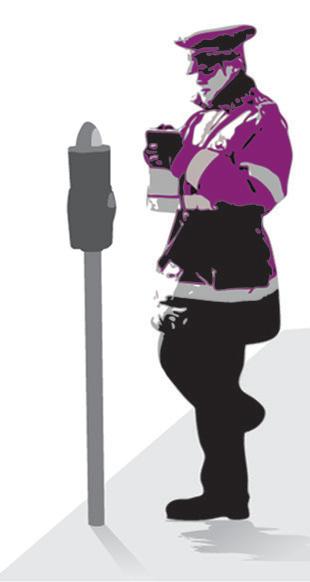
Ben Cooke, chief executive of UKPC said: “Since its inception, UKPC has become the UK’s leading name in parking enforcement and our resulting experience and expertise has provided a unique insight in to the parking market. Intelli-Park is a natural next step
Logistics UK’s new public affairs will focus on relationships with UK and devolved parliaments and governments, including regional mayors and combined authorities.
The team will be led by Ben Garratt – who joins Logistics UK as deputy director for public affairs –and will include Natalie Chapman, previously head of policy for the South, who becomes head of public affairs, and Emily Wood, who joins as public affairs and policy advisor.
Ben Garratt was previously head of stakeholder engagement at intercity train operator LNER and, before that, as head of rail communications at the Department for Transport. He will lead the development of Logistics UK’s public affairs strategy.
Emily Wood joins from Westminster-based public affairs, PR and digital marketing agency PLMR. She will lead on innovation policy, as well as public affairs. Her role will involve supporting the development and progress of public affairs activity at Logistics UK, and shaping the content and delivery of public policy positions.
Logistics UK has also appointed Ellis Shelton to its policy team as an

advisor. Shelton graduated from the University of Leeds with an MA in Social and Political Thought. He joins from Make UK where he worked as a policy and campaigns advisor. He will lead on rail policy, as well as supporting Logistics UK’s air and water policy work.

Ben Garratt said: “Logistics UK is well respected across government for its evidence-based policy work, and I am thrilled to lead its new Public Affairs team. I look forward to strengthening the business group’s relationships with government and stakeholders to maximise the impact of our work, and to raise awareness of a sector supporting growth, productivity and aspiration in communities across the country.”
for us, building technology into our unparalleled knowledge bank, so that customers can leverage a vast and informative data pool to inform commercial decisions and improve their own ways of working. It’s an exciting opportunity and we are looking forward to seeing the positive impact that Intelli-Park and exciting new technology will have on the parking industry.”
Silcock has over 20 years’ experience in business development and nearly 10 years’ experience specifically working in the parking sector so she is a wellknown member of the UK parking industry.

She has previously held senior sales roles in three other software providers in the sector – Imperial, Taranto Systems and most recently Unity5.

We currently supply and have vacancies around the UK for Permanent and Temporary positions:
• Civil Enforcement Officers
• Environmental Enforcement Officers
• Parking Back Office (Appeals/Notice Processing/Correspondence)
• Parking Change Management
• Interim Parking Managers
• Car Park Attendants/Marshalls/Stewarding
• Parking Supervisors (Both Enforcement and Back Office)
• Parking Management (Both Enforcement and Back Office)
• Heads of Parking/Directors
• Parking Technologies (Business Development and Project Managers/ Field Service Engineers/General Managers)
• Off Street Parking (Business Development, Contract Managers and Regional Managers)
• CCTV Operators – SIA and BTEC qualified
Looking for staff or need employment?
Please contact our experienced team on:
Tel: 0203 668 5680
Email: parking@unity-recruitment.co.uk

Web: www.unity-recruitment.co.uk
 Sharon Silcock has joined parking systems manufacturer Metric Group as its UK head of sales. Her role will be focussed on helping Metric bring new parking management software solutions to the UK market.
Sharon Silcock has joined parking systems manufacturer Metric Group as its UK head of sales. Her role will be focussed on helping Metric bring new parking management software solutions to the UK market.
Akey element of moving traffic enforcement is the need for high quality evidence. Providing clear images and video footage of a contravention means a recipient of a penalty charge notice (PCN) will accept, without argument, that they have committed an offence. This is crucial, as it is the challenging of PCNs that results in increased costs, affects public acceptability and impacts on the authority’s reputation. On a technical level, the Vehicle Certification Agency (VCA) certification process is very prescriptive. Its focus is on the security and evidential integrity of the system, for example, can the evidence be trusted and is it visible and readable to the naked eye?
You will want working cameras that are able to detect all potential moving traffic contraventions, are reliable and working all the time. Capture rates and availability are key expectations. When a potential moving traffic contravention is observed, the ability of the camera to correctly read and interpret the number plate and identify the vehicle’s characteristics will reduce wasted effort.
Another key expectation is efficiency. Having a camera that is able to capture a potential traffic contravention and determine whether it is actually a contravention or whether it is it a permitted vehicle movement is vital. After all, the majority of motorists do abide by the rules of the road and it is generally the minority that abuse traffic regulations and endanger other road users. So, the ability to sort the wheat from the chaff at the roadside is really important.
Once we have good quality contraventions, the ability to efficiently validate them through the manual review process
provides further efficiencies. And the main outcome is compliance. Many of you will be asked by residents and councillors to address particular problems in their areas. But how do you know whether there is actually a problem and, more importantly, how do you know when that problem has been satisfactorily addressed?
The VCA guidance sets down some very average requirements in terms of capture rate and correct read rate – but these should be looked at as minimum requirements.

Technology is constantly improving and you should expect, or rather demand, that cameras are able to capture clear, quality evidence in all lighting and weather conditions 24 hours a day, 365 days a year. You should certainly not settle for the minimum requirements in the VCA guidance.
Also, be wary of suppliers’ claims of their cameras performance. In a real life case study we undertook during 2022, two Neology cameras were installed at a location where there were seven cameras from a competitor. Over a period of one week Neology’s cameras achieved an average correct read rate of 98.76% compared with the 96.13% correct read rate of the existing cameras.
Whilst both camera set-ups were capturing close to 100% of all passing vehicles, the volume of misreads being generated by the Neology cameras was significantly less than that of the competitor’s cameras – which operationally translates into less manual review volumes and therefore lower operational costs.
Using a combination of primary ANPR and secondary ANPR, our cameras are able to achieve in excess of 99% accuracy. There

have been cases where traditional camera solutions incorrectly interpreted the number plate. Our solution, using the combination of primary and secondary ANPR reads, has resulted in the number plate being correctly read. It also uses MANTIS, which is our artificial intelligence (AI) software that is able to capture the vehicle characteristics from the images including vehicle make and vehicle type which are particularly relevant for many moving traffic contraventions and provide additional valuable information for downstream processing
Having correctly identified the vehicle and its characteristics, you then need to understand the context of the vehicle movement and ultimately whether that movement is permitted, or whether the vehicle making the movement is permitted to do so.
Vehicle tracking assists in showing whether a vehicle movement is permitted or not by tracking both the number plate and the vehicle through the field of view of the camera.
The accurate number plate read and vehicle characteristics captured can be used to determine if the vehicle making that movement is a permitted vehicle, for example, a bus in a bus lane or a car passing a weight restriction, or if the vehicle is permanently or temporarily exempted as is the case with emergency vehicles or service vehicles.
into different work flows and managing permitted vehicle lists. This improves the efficiency of the manual review team. And the use of workflows to batch the same contraventions together will enable the manual reviewers to efficiently review and accept, reject or amend each contravention using the images and video evidence captured.

Whilst the camera solution will have been efficiently ignoring compliant vehicle movements, this data will still be captured for analysis. This means that for any location you will be able to determine actual compliance levels – as opposed to just the volume of contraventions. This data can then be used to inform policy and whether enforcement is making a difference and actually changing motorists’ behaviour. Where acceptable compliance has been achieved the flexibility of the camera solution, with its integrated modem, means that the cameras can be easily relocated to another location as all you need is a pole or column and a power supply.
Last but not least, there is the issue of whether to go for fixed redeployable cameras or mobile vehicle cameras. Mobile vehicle cameras will always sound attractive due to the speed at which they can be relocated, but that comes at a cost through the need to maintain and operate the vehicle. There are also issues around the effectiveness of enforcement. A mobile vehicle camera, which may or may not be present and is not always visible, is unlikely to change motorists’ behaviour in the long term as it will represents a risk/reward scenario.
Conversely, redeployable fixed cameras – which does not have the associated vehicle maintenance and people costs – offer comprehensive data about a location. They provide accurate data before, during and after an enforcement campaign regarding compliance levels, addressing specific issues that may vary throughout the year – for example, seasonal or specific events.
Processing data at the roadside is efficient. The use of ANPR and vehicle tracking detection methods to capture all information about the vehicle and its movements and processing it at the roadside results in reduced communication costs. It also means reduced storage requirements and ultimately reduced manual checking. Moving traffic contraventions can be split into two types of moving contraventions:
• The first type are traffic regulations that restrict use of the roadspace to specific vehicles such as bus and weight restrictions. For these types, the vehicle registration mark (VRM) read and vehicle information is used to check against a permitted vehicle list and against DVLA information to identify buses, taxis (if applicable) and emergency vehicles. It allows you to discard those at the roadside, leaving just non-permitted vehicle captures for processing through manual review.
• The second type are traffic regulations that apply to all vehicles such as yellow box junctions and one way restrictions. For these types, the use of the VRM read and vehicle information, compared with the DVLA data of the vehicle will increase the confidence of the information captured. But it is the vehicle tracking that would identify if a contravention had actually occurred ensuring quality evidence being passed to manual review.
Once the camera solution processes collected data at the roadside to accurately identify and capture potential contraventions, you now move on to the manual review. Whilst the camera solution will have captured only genuine contravention candidates, a flexible and efficient manual review system will further reduce processing time and therefore costs.
Easy to use screens provide management functionality, such as adding and removing users, filtering different contraventions
As an example, redeployable fixed cameras can prove very effective when used to enforce School Street schemes. The solution captures vehicles during specific times (days, times, etc.) and whether or not they are permitted vehicles (residents, service vehicles). The presence of the cameras sends a clear message to parents and other road users before, during and after an enforcement campaign.
Reployable cameras are flexible. Exemptions for service vehicles and residents vehicles can be managed through a simple interface and enforcement based on the entry and exit time of the vehicle.
Redeployable fixed cameras are more likely to change motorists behaviour in the long term as there will be no reward – only a PCN through the post!

And redeployable cameras can, as the name suggests, be brought back when needed. Although compliance will be achieved through an enforcement campaign, continued compliance with a traffic restriction will require ongoing enforcement campaigns as road users will change and continued communication campaigns and data collection on compliance levels will inform policy decisions and potentially road engineering decisions to continually reduce the risks to other road users and maintain and enhance.
Martin Gubby is business development and delivery lead, moving traffic and clean air zone enforcement at Neology. This piece is based on his presentation at the Moving Traffic Enforcement at the London Transport museum, sponsored by CDER Group and organised by Landor LINKS. www.neology.net
Cameras should capture clear, quality evidence in all lighting and weather conditions 24 hours a day, 365 days a year
Martin Gubby
As Oxfordshire County Council’s parking contractor, Conduent Transportation has trained its on-street civil enforcement officers to become the first in the country to participate in the ‘Ask for Angela’ campaign, which helps vulnerable members of the public in dangerous or uncomfortable situations.

The data on the nature and prevalence of violence against women and girls in England and Wales is stark and shocking. For example, according to the Femicide Census, between 2009 and 2019, on average, one woman was killed by a man every three days in the UK.
Transport Champions for the Tackling Violence Against Women and Girls Strategy, Laura Shoaf and Anne Shaw, recently carried out a poll which found that 50% of women said that they avoided walking as a form of transport because they don’t feel safe. The
Infrastructure and Cities for Economic Development (ICED) Report 2017 estimated that up to 3.7% of GDP can be lost through women’s fears in accessing employment, tourism, and leisure journeys.
Millions of crimes of violence, abuse and harassment against women and girls are recorded each year. About 1-in-3 women worldwide have experienced either physical and/or sexual intimate partner violence or non-partner sexual violence in their lifetime, according to global estimates published by the World Health Organisation (WHO). Many offences never come to the attention of the police.
Violence against women and girls is the most widespread form of abuse worldwide, affecting one third of all women in their lifetime (WHO). It is this catalogue of appalling statistics and crimes that makes the ‘Ask for Angela’ campaign so important.
The ‘Ask for Angela’ initiative was originally developed by Lincolnshire County Council, as part of the #NoMore campaign. It was designed to help keep women on a night out, safe when in a bar or nightclub. Women who felt unsafe, vulnerable, or threatened could discreetly seek help by approaching a member of staff at a participating venue and ask them for ‘Angela’.
Jade Neville, Head of User Experience, EMEA, Conduent TransportationConduent Transportation’s front line team in Oxfordshire
This code-phrase indicated that the person required help with their situation. A trained member of staff would then look to support and assist them through reuniting them with a friend, seeing them to a taxi, or by calling venue security and/or the police.
‘Ask for Angela’ was then adopted by the Metropolitan Police in 2016 as a localised initiative by its police licensing officers. The initiative was rolled out to bars, clubs, and other licensed businesses across London.

The introduction of Safer Sound’s Welfare And Vulnerability Engagement (WAVE) training in 2017 underpinned the delivery of “Ask for Angela”, and more venues across the country began to take part in the “Ask for Angela” initiative and provide their employees with WAVE training.
In 2021, with the issue of violence against women and girls very much in the public consciousness, Conduent Transportation identified our officers as a valuable resource to help tackle violence against women, girls, and vulnerable people by expanding the ‘Ask for Angela’ campaign outside of the hospitality industry.
Conduent reached out to specialist training company, Safer Sounds, to help us develop on-street parking civil enforcement officer (CEO) specific WAVE training to help CEOs identify, not only vulnerable women and girls, but all vulnerable individuals in need of assistance.
A working group was organised which included WAVE experts, the Conduent management team and civil enforcement officers. The group explored how on duty CEOs could help to tackle abusive behaviour and threats of gender-based violence that could result in physical, sexual or psychological harm.
The group examined various situations and experiences of abuse or potential violence that CEOs had encountered whilst on duty. This enabled the WAVE training specialists to gain a better understanding of the types of situations and vulnerabilities of individuals that a CEO may encounter during their onstreet shift. Working alongside WAVE training specialists, Emma Moses, Conduent Transportations training manager, was able
to include scenarios based on real life incidents within the CEO specific training modules.
The training was also designed to be emotive and promote positive discussions not just about the mitigation that can be put in place to tackle public vulnerability on the street whilst CEOs are on duty, but also to educate our CEOs on how ending violence against women and girls is an effort that includes everyone in our society.
As a result of this training, Conduent's onstreet parking officers that work across Oxfordshire are now part of the ‘Ask for Angela’ campaign, working with Thames Valley Police and Oxfordshire County Council. The training was extended to include Oxford City Council's ODS parking officers, ensuring a consistent approach throughout the county's parking services.

Everyone has a part to play in helping the vulnerable, through ‘Ask for Angela’, Conduent is now playing its part across the streets of Oxfordshire.
Conduent Transportation is a leading provider of automated and analyticsbased smart mobility solutions for government agencies. These solutions span roadway charging and management, parking and kerbside management, and advanced transit and public safety systems. Our intelligent kerbside management systems enable an improved customer experience and provide operational efficiencies by augmenting the integration of people, technology and data for our customers and drivers.
transportation.conduent.com

Ending violence against women and girls is an effort that includes everyone in our society
Jade NevilleA WAVE training session
Traffic + Parking 2022 explored the future of urban mobility, reports Mark Moran
Traffic and parking teams provide an essential service. Local authorities and their partners are focussed on reducing traffic congestion, ensuring the safety of pedestrians and supporting the local economy.
These teams also have a key role to play in moving traffic regulations, delivering clean air schemes and enabling the transition to electric vehicles. These were among the themes discussed by the parking professionals who gathered in Manchester for Traffic + Parking

2022. Programmed by Parking Review and sponsored by Project Centre, the day comprised five key sessions:
• Moving traffic regulation and enforcement
• Creating better streets
• Enabling the new mobility
• Managing traffic and parking at events
• Payment and data technology showcase.
We are planning to build on the debates and discussions for Traffic + Parking 2023, which takes place at the Manchester Conference Centre on 15 November. www.traffic-parking.co.uk
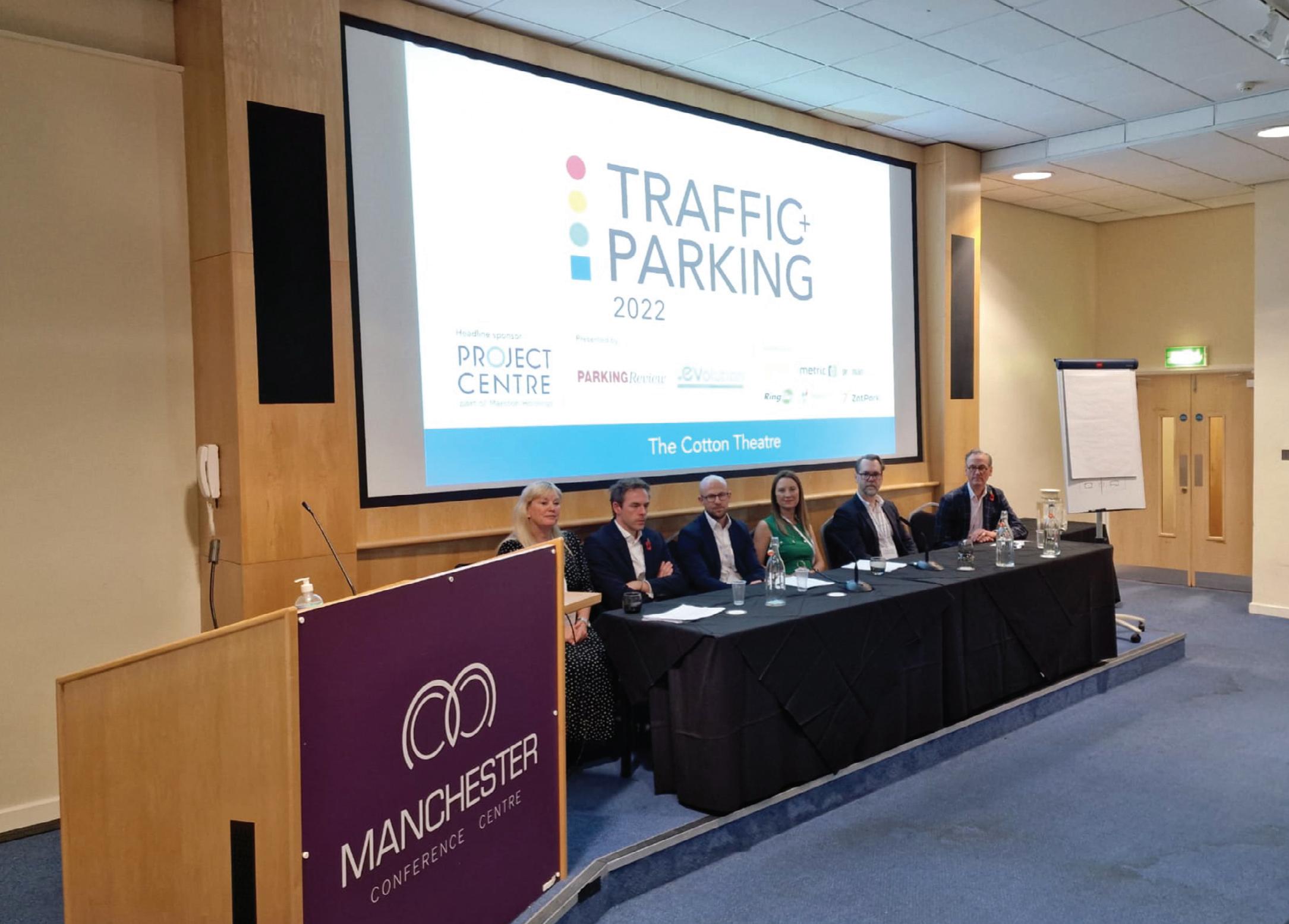
The opening session at Traffic +Parking 2022 examined the central role that local authorities play in enabling access to town and city centres, reducing congestion and improving air quality. The stimulating debate was chaired by Caroline Hamilton, chief adjudicator of the Traffic Penalty Tribunal.
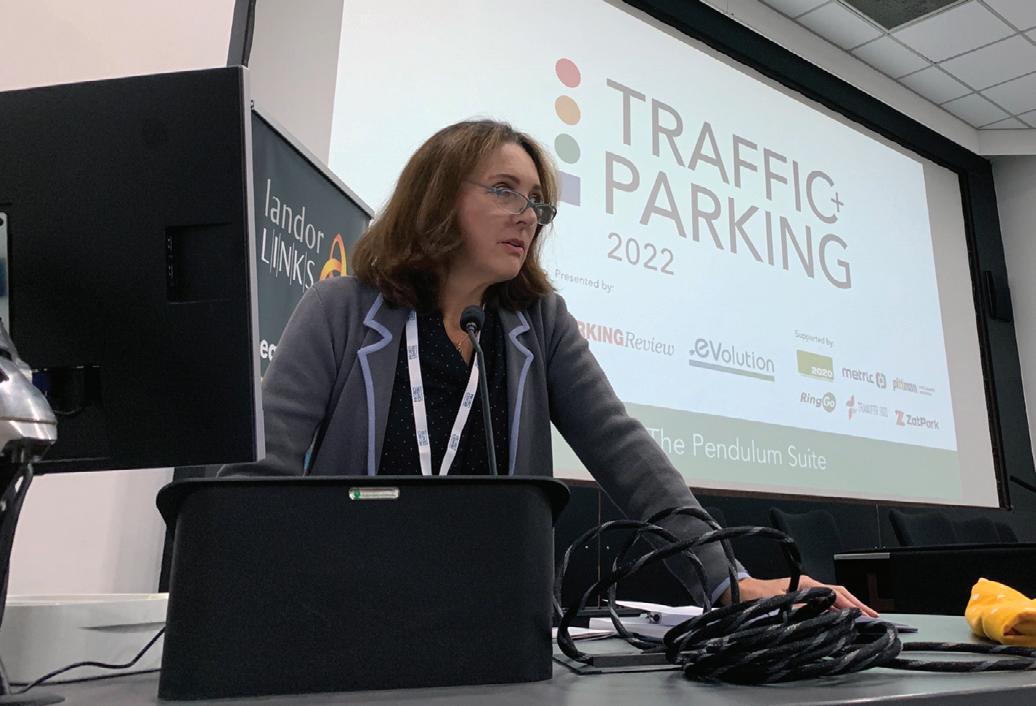
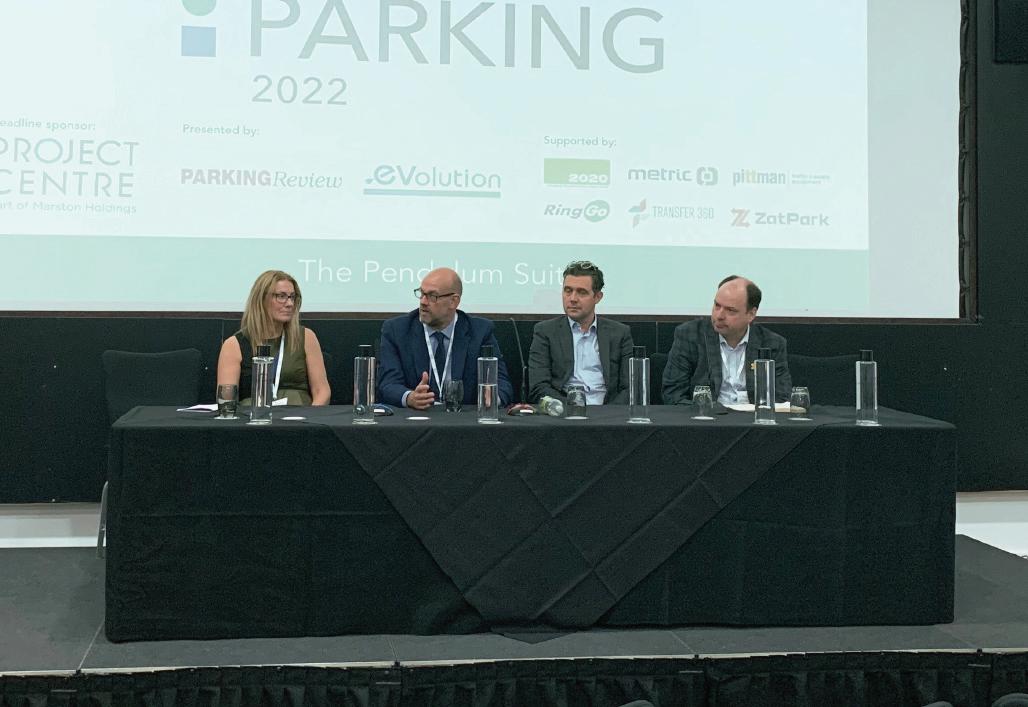
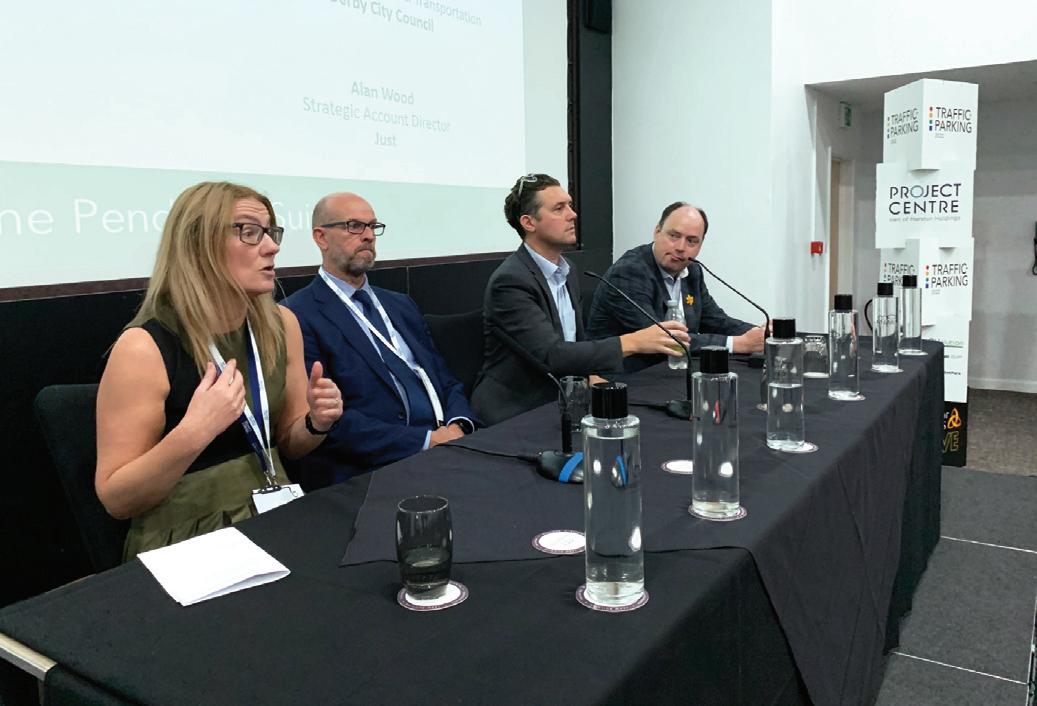
People-friendly streets, active travel and the new mobility: How can we get drivers to share our journey?
The keynote address by Nick Ruxton-Boyle, director of environment at Marston Holdings, provided an analysis of the best practises for creating low traffic neighbourhoods. He identified some of the main areas to investigate prior to the scheme’s development:

• Analysis of air quality across the area
• Understanding of parents and stakeholders’ behaviour
• Identifying barriers to people using sustainable ways of transport.
By collecting the above data, engineers and transport planners should seek to provide solutions to integrate long-term active travel plans. The objective is to leverage existing habits, encouraging communities to adopt modes of travel such as public transport, cycling or walking.
The approval of Part 6 of the Traffic Management Act 2004 has given local authorities outside London the ability to enforce moving traffic regulations such as banned turns, box junctions and other rules. To be designated as enforcement authority, local authorities need to apply to the Department for Transport. Tina Glover, associate director at the Project Centre, offered advice on how to implement moving traffic enforcement schemes, suggesting:
• Setting up a project board for highways, parking, legal, finance, and traffic management
• Early engagement with local communities and stakeholders to provide information about the change in legislation
• Collaboration with the police, neighbourhood teams, parking enforcement team, and transport authorities
• Prioritising enforcement sites based on set criteria that can be scored using “non-monetary” benefits
• Applying a consistent approach across regions
• Taking the opportunity to validate Traffic Regulation Orders.
Talent and technology keep the city moving
Derby City Council was one of the first English local authorities to adopt Part 6 moving traffic enforcement powers. Rob Shoebridge, group manager for traffic and transportation, shared insights on how the council engaged with communities to identify priority locations, such as School Streets, that needed to be enforced. During the implementation phase, warning letters rather than penalty charge notices were issued to underline that the council’s aim is to tackle congestion and improve road safety rather than raise revenue.
NPED: The National Persistent Evader Database
Alan Wood, strategic account director at Just, unveiled the National Persistent Evaders Database. NPED is an initiative that Wood has developed with the cooperation of the Cabinet Office under the Digital Economy Act. He set out how it will help police forces and local authorities remove nuisance vehicles from our streets.

Traffic and parking teams are at the forefront of managing streets and kerbsides. The Better Streets session, chaired by Joseph Burbidge, technical director at Project Centre, looked at clean air strategies, street management schemes and the smart use of data.


Introducing local road management schemes
Adam Bunce, managing director of 2020 Consultancy, provided a comprehensive guide to planning low traffic neighbourhoods, controlled parking zones and 20mph zones. He showed how combining these approaches can create safe, appealing communities where people feel safe to move around and enjoy living.
Bunce is an advocate of 20-minute neighbourhoods, places where a community can access most of their daily needs within a 20-minute round trip from their homes. A 20-minute neighbourhood requires a high quality provision of safe cycling routes and public transport to ensure there are sustainable travel options available for a variety of residents.
School Streets: Lessons learned
Andrea Jones, director of strategic accounts at Marston Holdings, discussed the planning and management of School Streets schemes. These use camera-enforced permits to only allow residents and service vehicles to have access to roads around schools during drop-off and pick-up times. School Streets can thus encourage families to move away from the car and instead embrace walking and cycling.
Mapping the kerbside
Olaseni Koya, associate director for parking at the Project Centre, talked about how mapping the kerbside can benefit local authorities. Data from mapping the kerbside can be analysed to understand how the space is being used and how it could be optimised. Koya outlined the main benefits of mapping the kerbside, which were:
• Better accuracy of kerbside assets and restrictions
• Reduced pollution by making information more accessible

• A more efficient and flexible approach to kerbside management
• Intelligent parking solutions such as bookable loading bays
• Linking kerbspace information to other solutions including air quality monitoring and traffic monitoring.
Traffic and parking teams play a key role in ensuring sports and special events take place successfully and safely. Two leading local authority parking managers led a lively and informative session that explored issues such as: emergency traffic order making; suspensions and road closures; liaising with venues and event organisers; staff deployment; public consultation; and cross departmental and multi-agency working.
• Anjna Patel MBE, principal officer at Sandwell Metropolitan Borough Council, shared lessons from her team’s work on managing streets and vehicle access to the Birmingham Commonwealth Games.

• Steven Foster, team manager of Newcastle City Council parking services, talked about working with St James’s Park, home of Newcastle FC, and how the parking services team helped the iconic Great North Run make a triumphant return after lockdown.

Traffic + Parking looked at how local authorities are supporting new modes of travel and connectivity, including electric vehicles, shared cars, bike-hire and electric scooters. The session, which was chaired by Chris Durban, technical director for transport at Project Centre, paid particular attention to how the parking and electric vehicle charging infrastructure sectors are converging.
Electric avenues: Rolling out EV charging in urban areas
Kieran Taylor, lead consultant on electric vehicles, Project Centre, explored the importance of rolling out EV charging points across the UK and how the key to the implementation of EV charging points is to install the right charger in the right place. The UK government is ending sales of petrol and diesel cars in 2030, meaning EVs will be the norm. Local authorities should prepare themselves for this transition by quantifying and designing solutions to their infrastructure gaps.
Partnership working delivers EV infrastructure
Shamala Evans-Gadgil is project manager, transport, infrastructure and innovation at Coventry City Council, which has one of the most comprehensive EV charging networks outside London. She provided insights into sourcing public funding for EV infrastructure, charger site selection and planning the ongoing maintenance of a network.
Keith Kelly is head of partnerships at Enterprise Car Club, which is working on plans to electrify its fleet of shared vehicles. He shared the results of pilot schemes exploring how to provide electric vehicles to clubs in country towns, rural locations and at rail stations.

Dan Hubert is founder and chief executive of AppyWay, which has developed a suite of systems for monitoring the kerbside and managing traffic orders. He discussed the smart use of parking bay and kerbside usage data to assist in the transition to e-mobility.


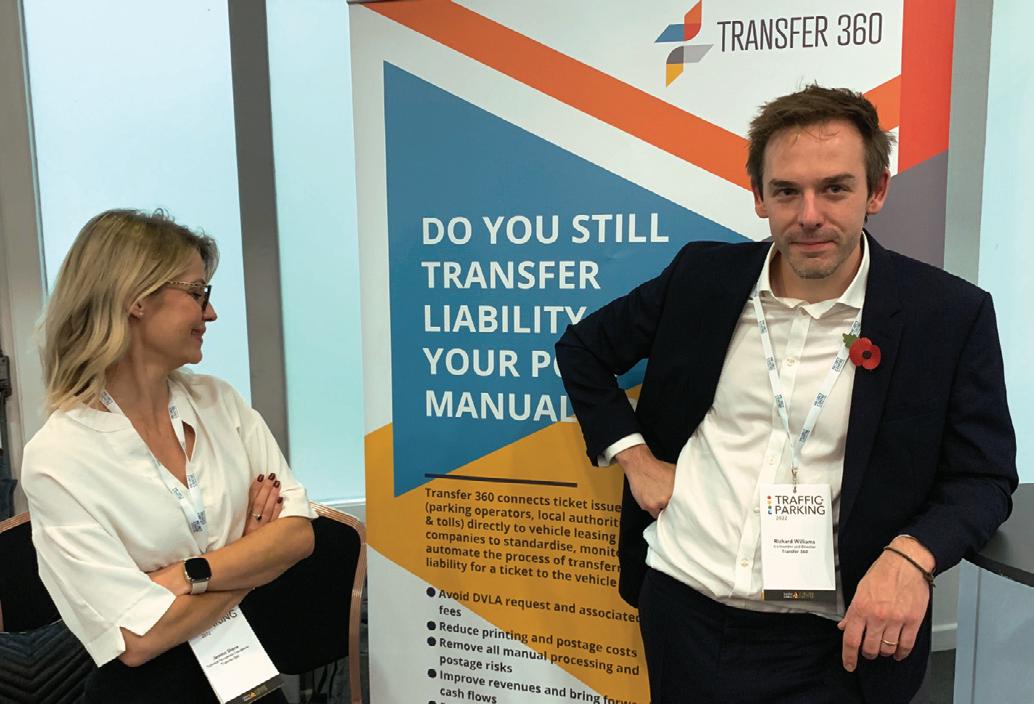
Traffic + Parking provides a forum via which exhibiting contractors and technology developers showcase new technologies and services that make the management of the kerbside and parking more efficient and effective.
The well attended showcase theatre saw a series of presentations that sparked a lively debate that continued into lunch:
The open market for parking payment
Andy Stott, sales director, RingGo
Carrier billing: Cashless payment for all Victoria Hull, head of bushiness development, Debit My Mobile Lease and fleet vehicles: Challenges and solutions
Richard Williams, co-founder and director, Transfer 360
Unlocking the customer journey
Matt Iveson, commercial manager, Sagoss Group
Helping all drivers understand the appeals process
Jason Barbour, managing director, Barbour Logic.
Manchester Conference Centre, 15 November
To find out more visit: www.traffic-parking.uk
The Covent Garden car park in Leamington Spa is to be shut down due to structural problems. The multi-storey will permanently close to the public on Sunday 12 February.

The closure decision has been made by Warwick District Council, which has been closely monitoring the structure of the building for several years. Parts of the facility were sealed off in 2019 and ongoing issues of antisocial behaviour led to the closure of upper levels 5 and 6.
With the cost of repairs likely to be high, the council’s cabinet is considering a report on the demolition of the car park.
Warwick District Council’s portfolio holder for neighbourhood services, Cllr Moira-Ann Grainger commented: “Although this has been a difficult decision, our priority must be the ongoing safety of car park users and the public. This closure isn’t unexpected, with over half of the car park already closed it has been long recognised that the car park was reaching the end of its useable life. Despite this closure, we are confident that there is sufficient parking in place to offset the temporary loss of spaces.
“We are working closely with the local community and businesses to ensure there is adequate parking to support the town centre future needs.”
The council has put in place plans to reduce the impact of the loss of the car park and to minimise any disruption to residents, businesses, and visitors. The adjacent Covent Garden surface car park will remain open. It has 80 parking spaces, of which eight are
mobility bays. Alternative car parking is also available at the St Peter’s multi-storey, Adelaide Bridge and the council HQ at Riverside House. Drivers are also to be encouraged to use the car parks in Old Town such as Court Street and Bath Place where people can park all day for £3. Covent Garden season ticket and permit holders have been offered alternative parking options.
The council also said improvements have been made to its car parks at Princes Drive and Archery Road and additional spaces have been added at Court Street, Upper Grove Street and Station Approach. Riverside House car park will provide up to 175 additional weekday spaces between 7.30am and 7.30pm.
If demolition of the Covent Garden car park is approved, the council said it will con-
tinue to work in partnership with the Leamington Transformation Board to bring the site forward as part of their ambitious programme of work to renew and regenerate Royal Leamington Spa town centre. This will be in tandem with other schemes currently underway including Spencer Yard and the Creative Quarter, with opportunities under consideration to bring both public services and key community facilities together in one location such as new car and cycle parks, and one-stop access to health and community services.
Meanwhile, there are proposals for a park & ride car park on the outskirts of Leamington in the future to help reduce congestion, pollution and improve the town centre’s air quality.
Luton Council is planning to redevelop a surface car park as part of wider town centre regeneration plans.
The Stage, a mixed-use redevelopment of Bute Street shoppers’ car park, is a key element of Luton’s Town Centre Masterplan.

The Stage is being part funded with £20m from the government’s Levelling Up fund. It will be made up of 405 new homes, a community facility with performance space, office and retail space, a cycle hub and improved public realm and will be situated where Bute Street car park currently stands, with an aim to complete the project by the end of 2025.
A public consultation is being

held following engagement with key stakeholders and interested parties which took place at the end of last year.
During the engagement exercise, stakeholders provided feedback on building design, transport, accessibility, sustainability ideas and layout
of the high quality public spaces. The council reports that there was useful discussion during the stakeholder engagement about how the development could help attract more people and businesses to Luton and encourage them to stay, how the designs could
help develop a safer and cleaner and more attractive area. It was felt the scheme would improve the image of Luton and enhance the town for the benefit of Lutonians as well as visitors.
Cllr Sian Goding, portfolio holder for regeneration and inclusive growth, said: “The Stage is such an important project for the town. Not only will it create a dynamic space but it will also help in our aims to level up Luton’s income inequality and eradicate poverty by creating hundreds of jobs throughout construction and once it has been completed. We had some really useful feedback late last year at our workshops which have helped inform the scheme’s design and refinement of the proposals.”
A new multi-storey car park has been opened in the Berkshire town of Maidenhead.

Opened by the Royal Borough of Windsor & Maidenhead the Vicus Way car park was built by the Buckingham Group at a cost £11.68m.
Located near the town’s railway station, Vicus Way has 500 spaces over 10 levels. There are 52 bays with fast chargers for electric vehicles, with the capacity to have further chargepoints added in future.
The car park was initially approved for construction in June 2018, but work on the project only commenced in 2021.

There had been debate about whether a new multi-storey was needed in light of the way in which the COVID-19 pandemic had changed travel patterns. However, the Royal Borough decided to proceed with the project, regarding it as a key piece of infrastructure that would support the town’s economy.
ber for planning, parking, highways and transport, said:
“Maidenhead is a growing town, supported by major investment from the council and private sector, and Vicus Way brings a modern parking offer to support that exciting investment and regeneration, some of which involves redevelopment of our older car parks.
“Vicus Way is for everyone to use, including for day parking. With its edge-of-centre location and proximity to the railway station, it is intended for longerterm use for day commuters and
town centre employees, supporting local businesses, freeing up other town centre parking for short stay use by shoppers, and providing an additional parking option for those using the Elizabeth Line from Maidenhead.”
The car park is open 6am to 8pm, Monday to Sunday, with charges applying from 9am to 8pm. Day parking is via the RingGo cashless parking system.
It is physically closed to vehicles and pedestrians from 8pm until 6am, due to its proximity to residential properties.

The Broadway car park in Maidenhead has been closed after concrete started falling from its ceiling. The 734-space multi-storey was shut on safety grounds on New Year’s Eve.
Investigations showed moisture in cracks in the concrete had caused masonry to break off and fall, said the Royal Borough of Windsor and Maidenhead.
The car park is over 40 years old and is due for demolition as part of the redevelopment of the Nicholsons shopping centre.
The Broadway car park was partially closed last summer due to anti-social behaviour. The decision to completely close the car park was made because heavy objects were being thrown from the roof, the local authority said.
A structural engineer will assess the condition of the car park, works which may include laboratory tests of the metalwork.
The car park would only reopen when it was made safe.
Organised by:
Presented by:
Mobility hubs are spaces where public, shared and active travel modes are co-located alongside improvements to the public realm. They enable travellers to make smooth and safe transfers between different modes, swapping private cars for shared vehicles, bikes, buses, trains, scooters or walking.
When reimagined as mobility hubs, car parks and park & ride sites are no longer just somewhere to store vehicles. Instead they become genuine interchanges. Meanwhile, the provision electric vehicle (EV) charging points at mobility hubs supports the transition to zeroemission vehicles.
The emergence of service hubs is also seeing car parks being transformed into logistics bases for last-mile delivery services, click & collect locations and homes to dark kitchens and dark stores.
The second annual Mobility Hubs conference sees speakers and expert panels explore the design, implementation and operation of mobility, EV and service hubs. The day will draw on real world experience and showcase best practice from around the UK and internationally.
The Mobility Hubs 2023 conference will address themes such as:
l Planning mobility hubs
l Developing service hubs
l Mobility hub design
l Making space for hubs in car parks
l Rethinking park & ride schemes
l Creating kerbside hubs
l Connecting with public transport
l Providing EV charging
l Hosting shared transport services
l Linking into active travel schemes
l Hub operation
l Hosting click & collect services
l Last-mile delivery schemes
l Scheme accreditation
If you are interested in speaking or taking part in a panel contact Mark Moran at: mark.moran@landor.co.uk
Who will be attending
l Car park operators
l Local authorities
l Property companies
l Car club operators
l Micro-mobility specialists
l Logistics companies

l EV charging providers
l Consultants
l Architects
l Facility managers
l Public transport operators
l Retailers
l Construction and refurbishment contractors

l App developers
l Technology providers
The event’s exhibition provides an excellent opportunity to showcase your systems and services. To find out how your organisation can be part of the day contact Jason Conboy on: jason.conboy@landor.co.uk


Editorial
Managing editor:
Mark Moran Tel: 020 7091 7871 mark.moran@landor.co.uk
Production and design production@landor.co.uk
Advertising, sponsorship, marketing and exhibition packages
Jason Conboy Tel: 020 7091 7895 jason@landor.co.uk


Subscriptions
Christina Pierre Tel: 020 7091 7959 subs@landor.co.uk
Accounts
Irina Cocks Tel: 020 7091 7854 irina.cocks@landor.co.uk
Business manager Rod Fletcher Tel: 0191 280 1410 Printed by: Pensord Tram Road, Pontllanfraith, Blackwood NP12 2YA Published
Electric cars are useless. This was the caustic opinion of the journalist Giles Coren when he announced his intention to go back to petrol after experiencing problems charging up his £65,000 Jaguar iPace.
Writing in The Times, he said: “The cars are useless, the infrastructure is not there and you’re honestly better off walking. Even on the really long journeys. In fact, especially on the long journeys. The short ones they can just about manage.”
In January Coren sparked a debate about the lack of public chargepoints which resonated with many EV drivers who had run into problems over the Christmas and New Year period. Disappointed drivers took to the airwaves and social media to share tales of long distance visits that took many more hours than planned, or which were abandoned altogether, because there was a paucity of chargers on main roads.
While Mr Coren has reverted to a petrol vehicle, this is only going to be a short-term option because the sale of fossil-fuelled vehicles will end by the end of the decade.
To support the transition to electric vehicles, the government’s ambition is that there will be 300,000 public EV chargepoints in place by 2030. The Competition and Markets Authority (CMA) has estimated 27,000 charging points will have to be installed each year to meet demand. To meet these targets, a concerted effort is needed by chargepoint network operators, motorway service operators, retailers and local authorities.
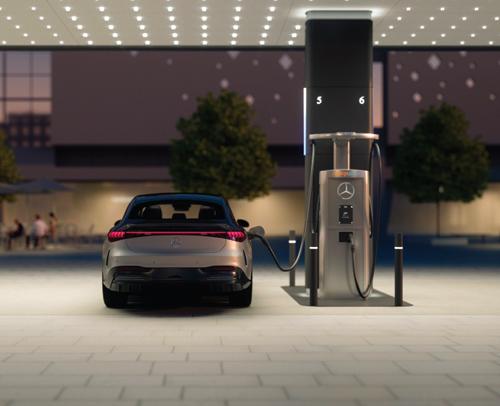
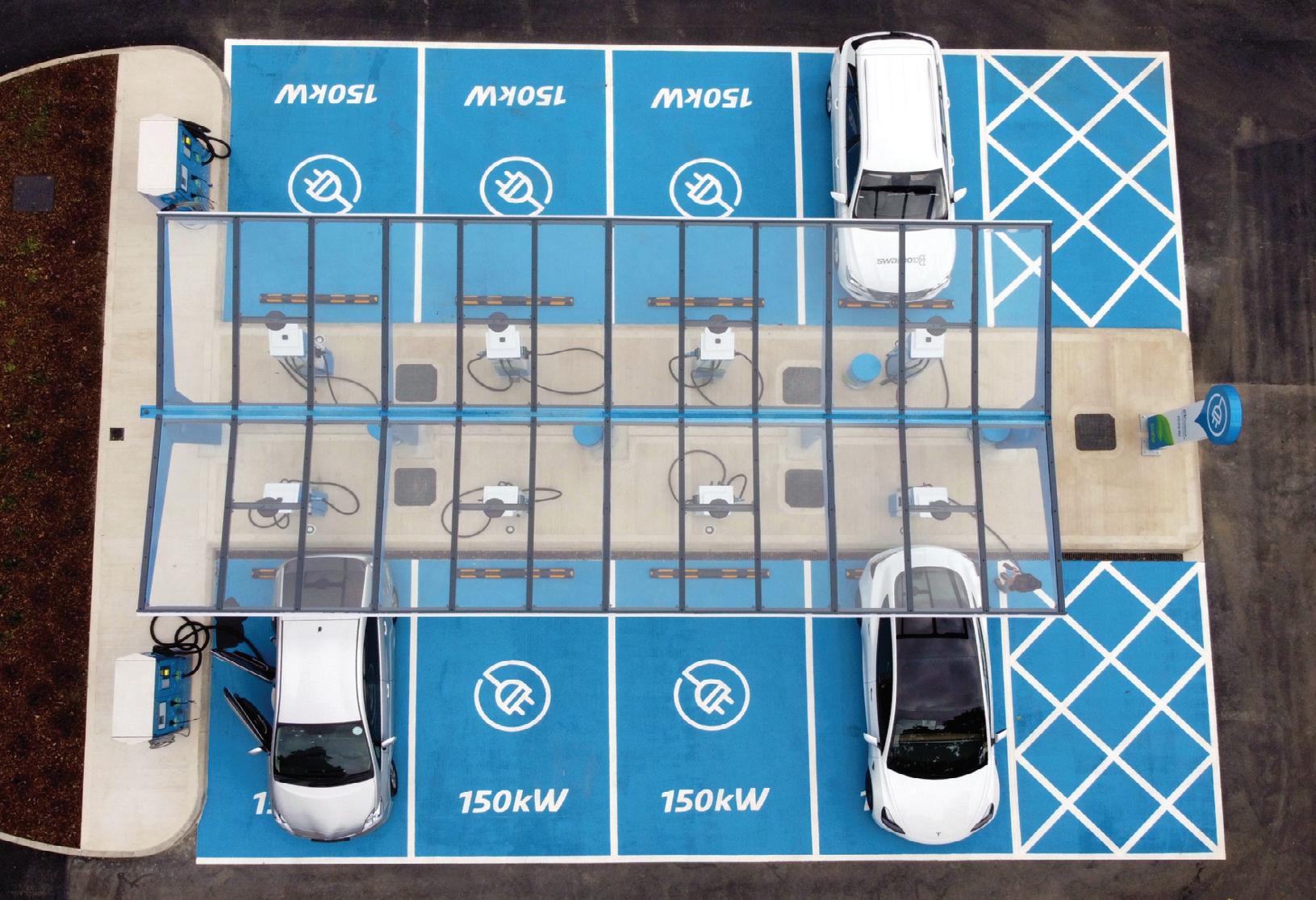

The signs, as evidenced in the pages of this magazine, are that there is a genuine desire to provide rapid, reliable and increasingly interoperable infrastructure.
 Mark Moran Editor
Mark Moran Editor
There is a genuine desire to provide rapid and reliable EV chargers
There were 37,055 public electric vehicle charging devices installed in the UK as of 1 January 2023. The latest electric vehicle charging statistics released by the Department for Transport (DfT) show that there has been an increase of 2,418 compared to 1 October 2022.
Some 6,887 were rated rapid devices or above, this represents 19% of all charging devices. 21,255 were rated fast chargers, which represents 57% of all charging devices.
A total of 18,321 were designated as destination chargers, which represents 49% of all charging devices.
Some 11,996 were designated as onstreet chargers, representing 32% of all charging devices
Compared to 1 October 2022, the total installed devices increased by 2,418, an increase of 7%. Rapid charging or above devices increased by 492, an increase of 8%. There was an increase in total charging devices and those rated rapid or above in all regions of the UK.
Proportionately, the largest increase in installations was within the ultra-rapid device category, which increased by 10% in the last quarter (albeit from a lower base than other categories), accounting for 211 charging devices. Ultra-rapid charging devices are still the smallest overall category with 2,295 devices.
Proportionately, the smallest increase in charging devices installations was in the slow charging devices categories, with an increase of 5% or 417 charging devices. Fast charging devices are still the most common category to be publicly installed, growing by 8% or 1,509 devices.

The most common location category for charging devices is destination with 18,321 charging devices or approximately half of all publicly available charging devices. Onstreet charging devices is the second largest category accounting for 32% of
charging devices or 11,996.
There is an uneven geographical distribution of charging devices within the UK. Some UK local authorities have bid for UK government funding for charging devices, and others have not. Most of the provision of this infrastructure has been market-led, with individual charging networks and other businesses (such as hotels) choosing where to install devices.
London and Scotland had the highest level of charging provision per 100,000 of population, with 131 and 69 devices per 100,000 respectively. In comparison, the average provision in the UK was 55 per 100,000.
Northern Ireland had the lowest level of charging device provision in the UK, with 19 devices per 100,000, followed by the North West and Yorkshire and the Humber with 31 and 36 devices per 100,000 respectively.
Scotland had the highest rate of rapid device provision of 17.3 rapid or quicker devices per 100,000, whilst the average provision in the UK was 10.3 per 100,000. Rapid or quicker device provision was lowest for Northern Ireland with 1.4 rapid or quicker devices per 100,000. North West and East of England were the second and third lowest regions with 8.3 and 8.9 rapid
The UK automotive sector has recorded its worst performance since 1956, according to the Society of Motor Manufacturers and Traders (SMMT). Volumes for the UK rose 9.4% but failed to offset declining exports, down -14.0%. UK car production is heavily weighted for export, with some eight in 10 cars shipped overseas.
However, record levels of electrified vehicles rolled off the assembly lines,
with almost a third of all cars made fully electric or hybrid.
The auto sector is calling for a dedicated framework to drive rapid upscaling of battery production, an issue highlighted by the collapse of the Britishvolt gigafactory project.
UK car production declined -9.8% in 2022 to 775,014 units, according to the latest figures issued by the SMMT. December rounded off a volatile year, with output down
or quicker devices per 100,000 respectively.
All regions across the UK saw an increase in total charging devices between October and December 2022. Wales had the greatest increase at 17.3%, whilst East Midlands had the smallest increase at 3.3%. London had the greatest increase in absolute number of devices at 493 devices, closely followed by Scotland at 486 devices.
The number of available devices can fluctuate for a range of reasons. Increases likely reflect the installation of new devices, whilst owners and operators can choose to temporarily or permanently decommission or replace devices.
Charging devices can also be unavailable due to faults, maintenance or other restrictions in the area where they are located, though data on the status of charging devices is not held by the Department for Transport.
Rapid charging or above devices have increased in every region in the UK. The smallest percentage increase in the number of rapid charging or above devices was in the South East at 3.3%. Wales had the largest percentage increase in rapid charging or above devices at 26.9%, corresponding to an increase of 60 rapid charging or above devices.
-17.9% in the month after growth in October and November, with most of the year’s volume loss occurring in the first half.
The annual total was 84,561 units down on 2021 and -40.5% off the 1,303,135 cars made in 2019 prepandemic, equivalent to a loss of more than half a million cars.
The main reasons for the depressed output were the crippling global shortage of semiconductors, which
limited the ability to build cars in line with demand; significant structural changes, reflecting a loss of production at two volume manufacturing sites; and the impact of supply chain pauses in China due to COVID lockdowns.
Despite these challenges, UK factories turned out a record 234,066 battery electric (BEV), plug-in hybrid (PHEV) and hybrid (HEV) electric vehicles, with combined volumes up 4.5% year-on-year to represent almost a third (30.2%) of all car production.


The UK’s electric vehicle infrastructure roll-out is on course to meet key government targets, such as delivering 300,000 chargers by 2030, says a new report. The Association for Renewable Energy and Clean Technology (REA) and research body New Automotive say the main barriers to EV roll-out include uncertainty within industry around future regulations, gaining planning permission for new chargepoint locations and the cost of upgrading existing local electricity connections to support higher usage.
The biggest barrier to growth identified by the industry stakeholders surveyed as part of the report was a lack of demand for public charging, and uncertainty around levels of demand in the future. If the government can assist industry in overcoming this barrier, it will help facilitate the UK’s public charging network expanding at a more rapid pace.

The report states that a government Zero Emission Vehicle (ZEV) mandate is the most effective way to drive EV uptake in the UK through guaranteeing the supply of electric cars, providing industry with certainty about future demand, and ensuring that the UK’s public charging network continues to grow at pace. The REA restates its call on government to not delay in introducing the ZEV mandate for new EV car sales, accelerating EV uptake and the net zero transition.

The On the Road to 2030 report reviewed the UK’s public charging network and found that are still cheaper to fill up than a petrol or diesel car at 70% of public chargers in the UK –those charging below 0.687 £/kWh.
New Automotive calculated that an electric car is cheaper per mile than a petrol car whenever it is charged at 69p per kWh, and around 70% of all public chargers in the UK are below this price.
The average cost of charging via Podpoint (47p/kWh), ChargePlace Scotland (30p/kWh), Ubitricity (42p/kWh), and BP Pulse (52p/kWh), collectively the four largest public providers in the UK, all fall well below this figure, meaning the majority of their chargepoints offer significant running cost savings to motorists compared to petrol vehicles. This means that an EV charged solely via a public charger is, more often than not, cheaper to run than a petrol car, regardless of the length of the journey.
Using a mixture of home charging as
well as fast and slow public chargers also works out significantly cheaper annually than an internal combustion engine (ICE) car. This is even if the vast majority takes place on a fast public charger (often the most expensive form of charging).
A driver who, over the course of the year, drives 6000 miles and charges their vehicle via a night time home tariff (26p/kWh) for 5% of the time; a day time home tariff (35p/kWh) 10% of the time; a free public tariff (0p/kWh) 5% of the time; and a public fast charger tariff (40p/kWh) 80% of the time would pay £626 a year on charging their EV. A driver who did the same mileage in a comparative ICE car would pay £947 a year on fuel – making electric the significantly cheaper option.
Amy MacConnachie, director of external affairs at the Association for Renewable Energy and Clean Technology (REA), said: “It is excellent news that this key sector report has found that EVs are indeed still cheaper to fill up than a petrol or diesel car, at 70% of public chargers in the UK (those charging below 0.687 £/kWh). It is positive messaging for drivers looking to make the switch, reinforcing effective infrastructure and low-cost incentives, putting to bed any ongoing concerns. There is, of course, more to be done however, and the report
makes clear that an ambitious ZEV mandate is essential to drive EV uptake by ensuring the supply of electric cars and providing industry with certainty around future demand. The REA is continuing to urge government to respond to the overriding message of the report, that there must be no delay in introducing the ZEV mandate for new and increasing EV car sales.”
New Automotive said: “The forthcoming ZEV mandate is the government’s most effective means of addressing this barrier; it should drive EV uptake by ensuring the supply of electric cars meets demand, and thus providing the EV charging infrastructure industry with certainty around future demand for public chargepoints. This certainty will go a long way to helping to ensure that the UK’s public charging network continues to expand at pace.
“More EVs on the road will not just help drive the roll-out of more public charging infrastructure. It will also mean more British motorists benefitting from the running-cost savings electric cars offer compared to petrol and diesel cars. The simple fact is that EVs save drivers money, whether they are charged at home or via the public charging network. In the midst of a generational cost-of-living crisis, these savings have never been more important to motorists. Given this, It is essential they are made accessible to all.”
Ending free or very low-cost pricing will attract the significant investment that is needed in Scotland’s public EV charging network over the next decade, according to new report from the Scottish Futures Trust. To ensure the long-term growth, sustainability and reliability of the public EV chargepoint network in Scotland, crucial private sector investment is needed to grow it at scale and pace according to a new report from public sector infrastructure body, the Scottish Futures Trust (SFT).
Following extensive engagement with the EV chargepoint market, the SFT report Public EV Charging in Scotland: Insight Report on Tariffs concludes that subsidised, or in some cases free charging applied by owners of chargepoints on the ChargePlace Scotland (CPS) network is deterring the crucial private sector investment needed to grow Scotland’s EV network over the next 5-10 years.
In the report, SFT recommends that local authority chargepoint owners:
• adopt a pricing regime that covers all costs and one which is broadly aligned with the market rate
• set out a timetable for the transition to market rate pricing and communicate with local EV drivers the benefits of enabling an expanded, accessible and reliable network
• explore the introduction of flexible and off-peak pricing structures to enable more affordable charging
• put processes in place to allow price
regimes to respond to changing energy costs in a timely manner.
EV chargepoints on the CPS network were initially made free for users following Scottish Government grants made to local authorities and public bodies in the early 2010s. Since then, Scotland’s overall public chargepoint network has grown to over 3,000, with over 2,400 of these now on the CPS network. With the highest number of public charging points of any UK nation or region outside London (per head of population), Scotland’s network currently supports a membership of 63,000 drivers, which is growing by around 500 every week.
Transport minister Jenny Gilruth said: “I welcome this report from the Scottish Futures Trust which will help inform our finalised vision for Scotland’s public EV charging network. We made it clear in our draft vision statement that a shift towards
The Irish government is to spend €100m on public electric vehicle charging infrastructure over the next three years. The Electric Vehicles Charging Infrastructure Strategy 2022-2025 presents a pathway for delivery of a national EV charging network which will see a pool of highpowered chargers placed every 6 km on the motorway network.
There will also be a roll-out of home and apartment charging, residential neighbourhood charging (including new mobility hubs), destination charging and en-route charging.
An accompanying implementation plan sets out a road map for the delivery of Ireland’s EV charging infrastructure over the next three years, assuring car users of the feasibility of switching to an EV, and enabling Ireland to meet its national
carbon reduction targets.
The €15m scheme from the Shared Island Fund will help sports clubs install electric vehicle chargepoints in local communities across the island of Ireland, so when people drop off kids or go to the club for their own use, they can charge their car at the same time. This will be just one form of destination charger. Others will be installed in locations such as retail centres or tourism spots, places where people may be driving to.
The strategy seeks to take a peoplefirst approach, focussing on seven user groups (or personas) illustrating different transport needs across different parts of the country both rural and urban, or in different housing types, for example. It then follows an individual’s journey from the planning stages to their return
a public charging network largely financed and operated by the commercial sector is necessary to grow the network at pace and improve the customer experience overall.
“It’s vital that the public charging network has tariffs which are fair, sustainable and are set at a rate which enables the private sector to invest right across the country in the long term.
“Underpinned by our newly designed £60m Public EV Infrastructure Fund –aimed at attracting in private investment –Scotland is well positioned to build on the strong foundations we have, respond collectively to the global climate emergency and deliver on our commitment to phase out the need for new petrol and diesel cars and vans by 2030.”

Andrew Bruce who leads the EV work at the Scottish Futures Trust, said: “Free or low-cost electric vehicle charging on the public network was a fantastic initiative put in place to encourage more people to use electric cars. However, as more and more people invest in electric vehicles, we now need to take a longer-term view on EV charging to ensure we have well maintained infrastructure and deliver a comprehensive network of chargepoints that are ready to cope with mass adoption.
“We know that competing against reduced tariffs is causing private sector chargepoint owners to hesitate to invest in Scotland’s network, which will limit its growth. Continuing to offer access to the network for free, or at such low rates, is also having unintended consequences. Data shows it could be encouraging people who could charge their vehicles at home to travel to access the public network, potentially preventing those who rely on the network most from accessing it.”
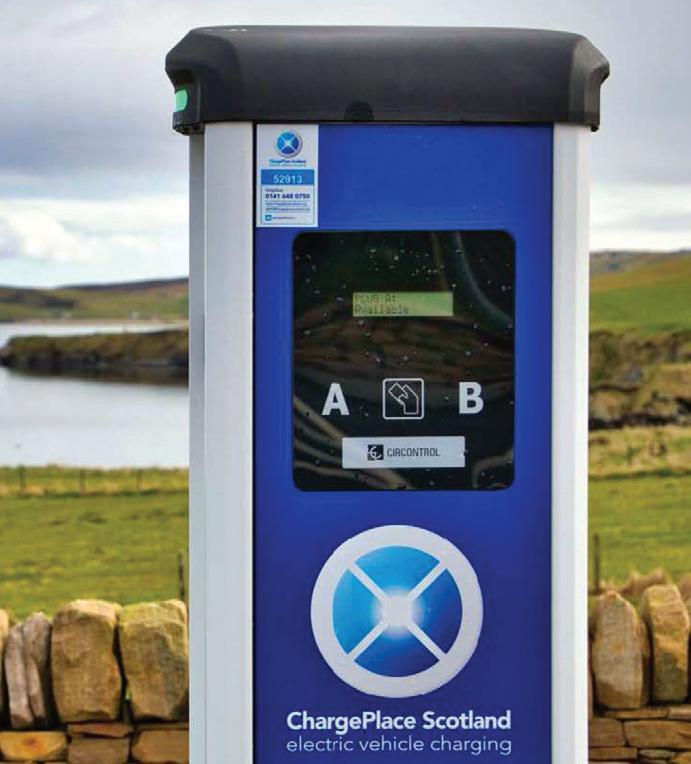
home, mirroring the needs of real people and groups. The strategy gives an insight into practical infrastructure adjustments that will make their EV driving experience easier.

Minister for Transport Eamon Ryan said: “The EV strategy sets out a road map for creating an entirely new infrastructure across the country –one that people can have confidence in and one that will encourage more and more people to choose EVs.
“It’s happening already – EV sales are sky-rocketing – but the new infrastructure we are planning should take away concern or worry that people might have about access to charging points. In all of this, our local authorities will play a vital role. The key anchor for this strategy is the specialist ZEVI unit.
“Within this unit, we have the
Electric Vehicle Charging Infrastructure Strategy 2022-2025 Department
expertise, the knowledge, the guidance, the resources that local authorities will need to be able to make the best decisions on the procurement, leasing and location of EV chargers.”

Ohme EV chargers weather the storms at Energy House 2.0
The built environment accounts for 40% of the UK’s carbon footprint and to achieve net zero will require a step change in the design of new buildings. As around 80% of the 2050 building stock has already been built, meeting this target will require a comprehensive upgrade and
retrofit programme to the existing housing stock.
Devising houses of the future is the mission of Energy House 2.0 at the University of Salford.

The £16m facility’s chambers contain fully furnished houses created by developers Barratt Developments, Bellway Homes, and Saint-Gobain.
Energy House 2.0 can recreate a wide variety of weather conditions with temperatures ranging between
-20˚C to +40˚C and simulated wind, rain, snow and solar radiation. The weather conditions will help the project partners to work together creating a blueprint for the low carbon homes of the future.
Energy House 2.0 is expected to play a key role in accelerating the progress towards low carbon and net zero housing design and builds upon the success of the original Energy House Laboratory, which was opened in Salford back in 2012.
Fitted to the houses inside the chambers are Ohme EV smart chargers.
The project will assess the performance of systems such as EV chargers, which are being supplied by Ohme.
“We’re very excited to be part of the Energy House 2.0 project and this view into the future of our housing,” said Ohme chief executive, David Watson. “This project will help to accelerate progress towards low carbon and net zero housing design.”
Britpave has called for the provision of concrete ‘electric roads’ that charge electric vehicles as they pass over them. E-roads enable vehicle batteries to be charged inductively via wireless systems using magnetic coils installed in the concrete road surface that feed an electric charge to magnetic coils fitted on a vehicle’s undercarriage.
The inadequacies of the UK electric car charging network were underlined by the annual Christmas getaway with queues of vehicles waiting for up to three hours for Tesla superchargers. Britpave, the infrastructure industry association, believes that the problems support the case for a different solution.
Members of the Tesla Owners Club UK took to social media to vent their frustration with the lengthy queues in Hertfordshire, Westmorland, Cumbria and Telford. Up to 40 cars were reported to be queuing for a charger at Westmorland, north west England. The queues happened as millions took to the roads for the Christmas holiday period.
There were 420,000 pure-electric cars on UK roads at the end of February 2022, according to the comparison website Next Green Car. These were served by only 30,290 charging points across Britain, of which 5,494 were rapid chargers.
“The number of electric cars significantly outweighs the number of charging points. As proven by the excessive queues over Christmas, this can result in problems for motorists wanting to ensure that their vehicle batteries are adequately charged for journeys,” said Joe Quirke, chairman of group Britpave.
“We believe that best way forward is the provision of concrete e-roads that charge electric vehicles as they pass over them. The long-term strength and performance of concrete makes it the better option for such roads as they do no need regular maintenance and in hot summers – such as the summer that we have just had – do not melt unlike asphalt roads. Road surface melting could dislodge and compromise the embedded coils.”
EV chargepoint management platform Fuuse and innovators in energy and EV charger manufacturing have been granted almost £200,000 to develop an endto-end V2X (vehicle-to-everything) DC microgrid solution for fleets. The project seeks to provide support for the National Grid as EV uptake continues to accelerate putting rising pressures on energy demand.
The project, already underway, explores the efficient distribution of energy between EV batteries and other site components such as buildings, other vehicles, or local generation sources such as solar panels and wind turbines.
Joining Fuuse are TPS (Turbo Power Systems), providing their Velox ultra rapid electric vehicle charging hardware which uniquely can both charge and discharge vehicle batteries to enable V2X. Whilst fleet electrification specialists, Gridicity, join the consortium to provide smart intelligent forecasting of energy demand and supply. Fuuse will collate these insights and determine
where the energy in the EV batteries will be moved from and to.
Powering the testbed on which to prove the capabilities of the new solution, is PNDC (Power Network Distribution Centre) based at the University of Strathclyde.

The grant funding comes as part of the government’s V2X innovation programme, part of a wider Flexible Innovation Programme to deliver a range of smart energy applications.
This phase of the project aims to test the concept in a controlled environment. Future developments will include real world testing with forward thinking fleets.
Launched in 2021, Fuuse is a back-office system for EV chargers, Dr Will Maden, chief operating officer of Fuuse, said: “As momentum for EV uptake accelerates and more pressure mounts on fleets to make the transition, we must focus our efforts on resilience, for not only organisation sites, but the wider Grid. We must enable fleets to transition as responsibly and efficiently as possible.”
The key recommendations are:
• leverage the expanding pre-owned ZEV market
• public charging and fuelling infrastructure
The major barriers to the adoption of zero-emission vehicles (ZEVs) among disadvantaged communities are their high cost and a lack of charging infrastructure, says a new report. Environmental Justice Impacts of Zero Emission Vehicles explores the barriers to an equitable transition to zero-emission vehicles.

Environmental justice is the fair treatment and meaningful involvement of all people with respect to the development, implementation, and enforcement of environmental laws, regulations, and policies.
Three ZEV markets – California and Michigan in the USA, and England – were selected for quantitative analysis of disparities in ZEV adoption, and of the major factors driving them in each market. In addition to quantitative analysis, the project team conducted a comprehensive environmental justice stakeholder engagement in the three markets to identify major barriers to adoption of ZEVs within lower-income regions and disadvantaged communities.
The engagement, formed of semistructured interviews and online workshops with 15 environmental justice
experts and engagement with 24 organisations dedicated to environmental justice, identified policies that local jurisdictions and governments could embrace to increase ZEV adoption and operation in disadvantaged communities.
The three major barriers in adoption of ZEVs within lower income regions and disadvantaged communities are: affordability; access to charging infrastructure; and the availability of mobility options.
Local authorities can now access reliable, up-to-date information and guidance about electric vehicles and infrastructure to inform chargepoint strategies and support effective deployments.
The National Electric Vehicle Insight and Strategy (NEVIS) service now includes a ‘Knowledge Repository’ to put the right advice and insight into the hands of those responsible for the deployment of EV infrastructure in England.
The online repository, revealed at the second LEVI Roadshow, aims to equip and engage local authorities to deliver EVI through a growing suite of Wikipedia-style searchable articles, images and videos.
The articles are divided into steps so that local authority officers can find information that is specific to them and the stage of the journey they are at. This includes those just starting out or developing their strategy, through to procurement and operations.
Since its launch at Cenex-LCV in September 2022, over 150 English
local authorities have registered for access as part of the Local Electric Vehicle Infrastructure (LEVI) Fund.
The LEVI Support Body, formed of Cenex, Energy Saving Trust and PA Consulting, provides expert technical and commercial support to enable successful LEVI applications for a share of the £400m capital grant scheme administered by OZEV. The support body offers preapplication support to shape and develop EVI vision, strategy and, ultimately, LEVI Fund proposals through assistance in understanding eligibility and establishing project fit against criteria.
Chloe Hampton, infrastructure strategy consultant at Cenex, said: “Any good EVI strategy, delivery plan or chargepoint operations management is grounded in reliable, up-to-date information.
“The launch of the Knowledge Repository means that local authorities have the highest-quality guidance at their fingertips, with links out to valuable external resources.”
• targeted incentives toward lower income regions
• community-driven decision-making
• support regions’ mobility alternatives
• the role of electrifying medium and heavy-duty trucks
• resilience and ability to manage change
• job transition.
The research was conducted for the International Zero-Emission Vehicle Alliance (IZEVA) by consultants ICF and GSMP partners Cenex and Forth Mobility. Cenex led on environmental justice stakeholder engagement in the EU and undertook data analysis to identify impact of policies in the UK.
Beth Morley, mobility and human insights manager, said: “ZEVs have great potential to improve public health, air quality, energy independence, and sustainability. However, challenges do exist with respect to affordability of ZEVs and equitable access to fuelling and charging infrastructure.
“There are some areas of the market not seeing adequate uptake in ZEV awareness or options, and we highly recommended that more be done to further outreach in marginalised communities.”
A new UK research hub will develop innovative measures to decarbonise and improve transport.
Decarbonisation minister Jesse Norman has announced applications are open for organisations to host the new hub, with the government pledging £10m in funding for the centre.
The Net Zero Transport for a Resilient Future Research Hub will be a partnership between government departments, industry and UK Research and Innovation (UKRI).
It is a joint programme between UKRI and the Department for Transport as part of the UKRI ‘Building a green future’ strategic theme. It will focus on climate adaptation and mitigation solutions for the UK transport system across modalities and landscapes.
Currently, transport accounts for 27% of the UK’s emissions and the Net Zero Transport for a Resilient Future Hub will drive decarbonisation solutions, such as greater use of recycled materials and reducing the carbon footprint of repairs and
maintenance.
The hub will also develop and implement innovative ideas to ensure future transport is resilient and meets the challenges of climate adaption, such as changes to weather and water levels. It will focus on the UK’s transport sector’s needs over the next 25 years as the government works to meet its 2050 net zero goals, helping to ensure the sector can build UK skills, jobs and innovation.
Jesse Norman said: “Innovation is key to the growth of the transport sector, and the creation of highskilled jobs and business opportunities across the UK. This new UK research hub will build a centre of excellence for the future development of low-carbon transport.
“By working to develop real-world solutions across a wide range of academic disciplines, such as architecture and design, computing and behavioural sciences, the hub will help support innovation in the UK which could lead to high-skilled jobs across the UK.”

Improving charging provision is a matter of social justice, says report
The Electric Vehicle Smart Charging Action Plan published by the UK government and Ofgem sets out steps being taken to maximise the potential of smart charging and make it the preferred method of long duration charging by 2025.
Smart charging harnesses the potential of energy use data and the latest energy innovations to deliver significant benefits for consumers, including allowing motorists to charge electric vehicles when electricity is cheaper or cleaner, allowing consumers to power their home using electricity stored in their electric vehicle, or even sell it back to the grid for profit.
The action plan highlights actions in three key areas to:
• make smart charging the affordable, convenient choice for consumers: increasing consumer confidence in smart charging and providing appropriate protections for a positive experience
• provide the right business landscape for electric vehicle smart charging products: regulations, standards and
innovation for safe goods and services that give consumers choice, and work for the charging market and energy flexibility
• create an energy system ready for electric vehicle smart charging: accessible tariffs and flexibility services that incentivise smart charging, plus energy system data and tools/measures in place to plan, incentivise and manage risks arising from EV flexibility, in the context of wider energy retail, network and market changes.
Electric vehicle consumers are set to benefit from lower energy bills and cheaper motoring thanks to a landmark plan to unlock the potential of smart electric vehicle charging. It is expected high mileage motorists could save up to £1,000 a year through smarter charging.
The government has also announced £16m funding from the Net Zero Innovation Portfolio (NZIP) for technologies that harness the potential of smart charging, including a smart street lamppost which will enable motorists to access smart charging on the move, and
projects that will enable domestic appliances, from heat pumps to electric vehicle chargepoints and batteries, to integrate into a smarter energy system.
The government states that delivering the action plan will help make smart charging the norm at home and work by 2025. It is the ambition that in the late 2020s smart charging will also become more commonplace at long-duration public charging, such as on-street or at transport hubs.
Depending on tariff, mileage, and charging patterns, smarter charging could save an average driver up to £200 a year, and a high mileage driver up to £1,000, by delaying the power demand from electric vehicles at peak periods, such as 4pm to 9pm on winter evenings. By helping to efficiently balance when energy is generated and used on the electricity grid, the technology could contribute to reducing electricity prices for consumers across the network.
New arrangements made by Ofgem to deliver the Market-Wide Half Hourly

Settlement (MHHS) Programme is designed to facilitate the uptake of smart charging through market incentives, in addition to removing barriers for V2X (vehicle to everything) energy exchanges.
Energy and climate minister Graham Stuart said: “We want to make smart charging an easier choice for drivers of electric vehicles, whether that is charging on the driveway, at the workplace, or parked on the street. To do that we need to build new network infrastructure at pace, using the latest available technologies. This plan sets out how we will work with Ofgem and industry to kickstart the market for smart charging, which we are backing up with £16m in innovation funding. This will let people take control of their energy usage, in the most convenient and low-cost way.”
Ofgem director for strategy and decarbonisation Neil Kenward said: “As energy regulator, we’re helping create the infrastructure to deliver Britain’s net zero future at the lowest cost to customers. This innovative plan will help to maximise the benefits of smart charging, offer vital savings to consumers and reduce the overall cost of energy by seizing the opportunities to use batteries to both power homes and fuel the wider grid.”
The announcements build on the steps taken by the government to enable smart and flexible electric vehicle charging. As of July 2022, all new chargepoints sold for private use now must have smart functionality and the UK is consulting on a new policy and technical framework to unlock the benefits of domestic smart, flexible energy, and enhance its cybersecurity.
Through the plan, the government will improve publicly available information and evidence on smart charging, support the implementation of robust consumer service standards and ensure private chargepoints are secure and compatible with the latest energy innovations.
The government hopes the roll out of intelligent and automated smart charging will deliver a win-win situation for all consumers. It is suggested reduced electricity system costs will lower prices for everyone, motorists will pay less for charging their electric vehicle, and the electricity powering electric vehicles will be cleaner and greener.
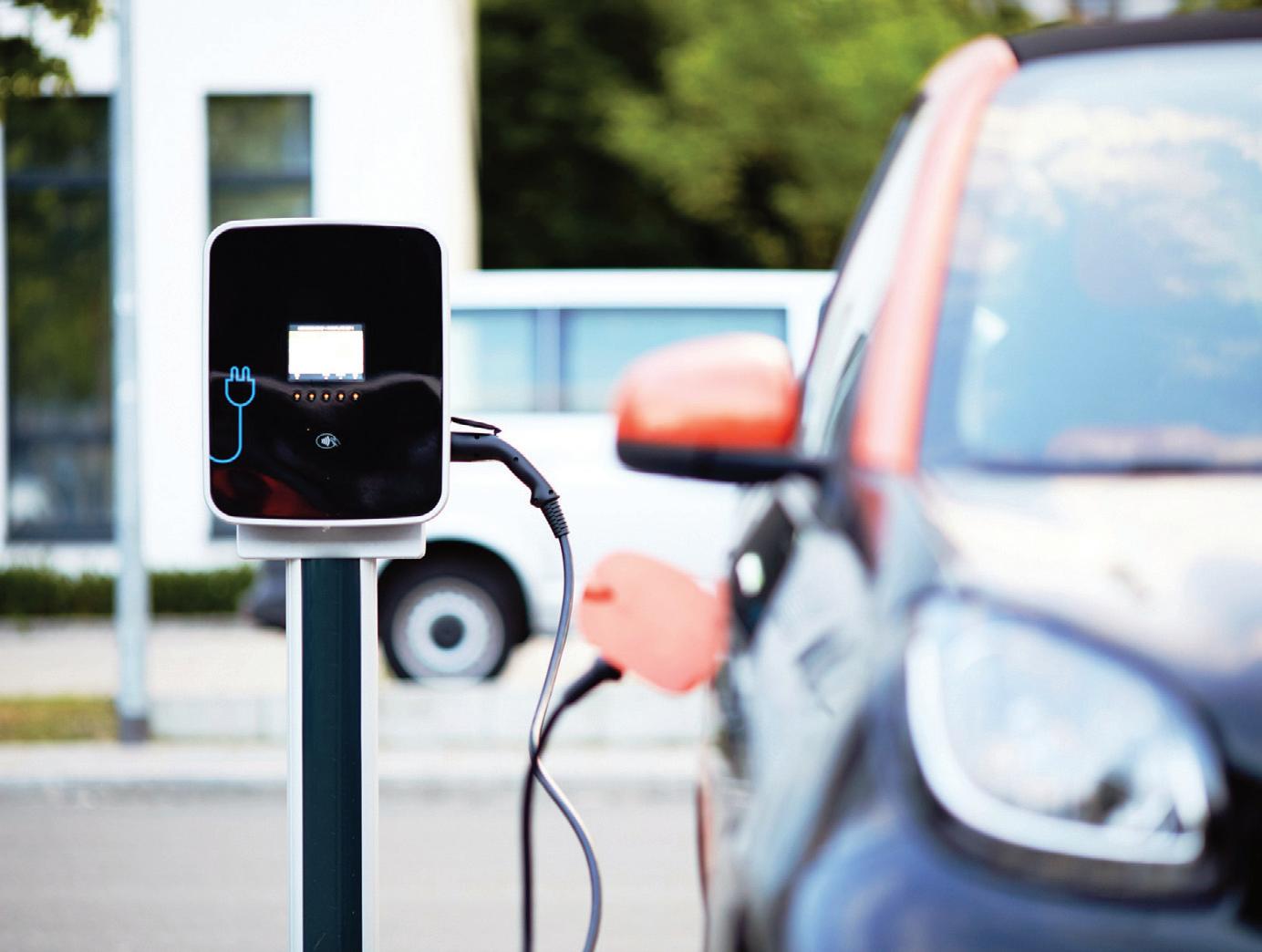
The government and Ofgem say they will seek to remove the barriers that currently prevent the full development of a diverse and competitive smart charging market, while making sure the energy system is ready to respond to the upturn in energy demand that electric vehicles will bring. The government has also announced it is looking at how to make data from all public chargepoints openly available so that consumers can easily find chargepoints suitable for their needs.
Delivering the steps set out in the action plan will help make smart charging the norm at home and work by 2025. It is the ambition that in the late 2020s smart charging will also become more commonplace at long-duration public charging, such as on-street or at transport hubs.
The V2X Innovation Programme and IDSR Programme are part of the overarching Flexibility Innovation Programme, which seeks to enable large-scale electricity system flexibility through smart, flexible, secure, and accessible technologies and markets through funding of up to £65m. The programme sits within the £1bn Net Zero Innovation Portfolio (NZIP).
Over £3.2m will be provided to projects through Phase 1 of the £12.6m V2X Innovation Programme to develop prototype hardware, software and business models that harness smart charging technology.
Over £12.8m will be provided to projects to develop and test smart energy solutions that can deliver demand side response (DSR) for consumers, decreasing or increasing energy consumption depending on price, availability or emissions. By giving consumers greater control over their energy use, projects funded through the Interoperable Demand-Side Response (IDSR) Programme will allow them to change their consumption patterns.
The IDSR programme consists of three streams of work, to support the innovation, design, and demonstration of interoperable demand side response systems. Smart meters, technologies, tariffs and services will enable consumers to change their consumption patterns to match times of cheap and abundant low carbon electricity, giving them greater control over their energy use and saving them money by helping to balance the energy system.
Schemes receiving funding through the V2X Innovation Programme for prototype hardware, software and business models include:
• Otaski Energy Solutions (Gateshead, Tyne and Wear): £229,000 to a project led by to develop a smart street lamppost capable of charging electric vehicles and sharing power back to the grid
• V2X-Flex (Reigate, Surrey): £220,000 to a project led by EV Dot Energy to develop prototype software and a new business model which will reduce entry barriers for the domestic use of V2X bi-directional chargers to provide energy flexibility services
• BEVScanV2X (London): £165,000 to a project led by Agile Charging Ltd to develop technology that could overcome battery degradation by creating a cost-effective tool to monitor and advise best approaches to maximise battery life and financial returns from smart charging.
The Interoperable Demand-Side Response (IDSR) Programme supports technologies that allow consumers to remotely increase or decrease their energy use to take advantage of when energy is cheaper or more renewables are on the grid. Schemes receiving funding include:
• Energy Smart Heat Pump (Chertsey, Surrey): £510,000 to a project by Samsung Electronics UK and their project partners Passiv UK to design and develop a technology solution that is able to provide demand side response (DSR) services via Samsung Heat Pumps, giving greater control of their usage on the basis of cost or carbon savings
• Smart-DSRFlex (Manchester): £1.2m to a project by Landis & Gyr UK to demonstrate how DSR technology can help to manage a renewablesbased electricity grid using the smart meter system
• Open DSR for All (Manchester): £29,000 to a project by Carbon Co-op to explore the benefits and technical barriers to an accessible approach to domestic DSR, potentially enabling more products being able to offer DSR in future. Depending on tariff, mileage, and charging patterns, smarter charging could save an average driver up to £200, and a high mileage driver up to £1000 a year by delaying the power demand from electric vehicles at peak periods, such as 4pm to 9pm on winter evenings. By helping to efficiently balance when energy is generated and used on the electricity grid, the technology could contribute to reducing electricity prices for consumers across the network.
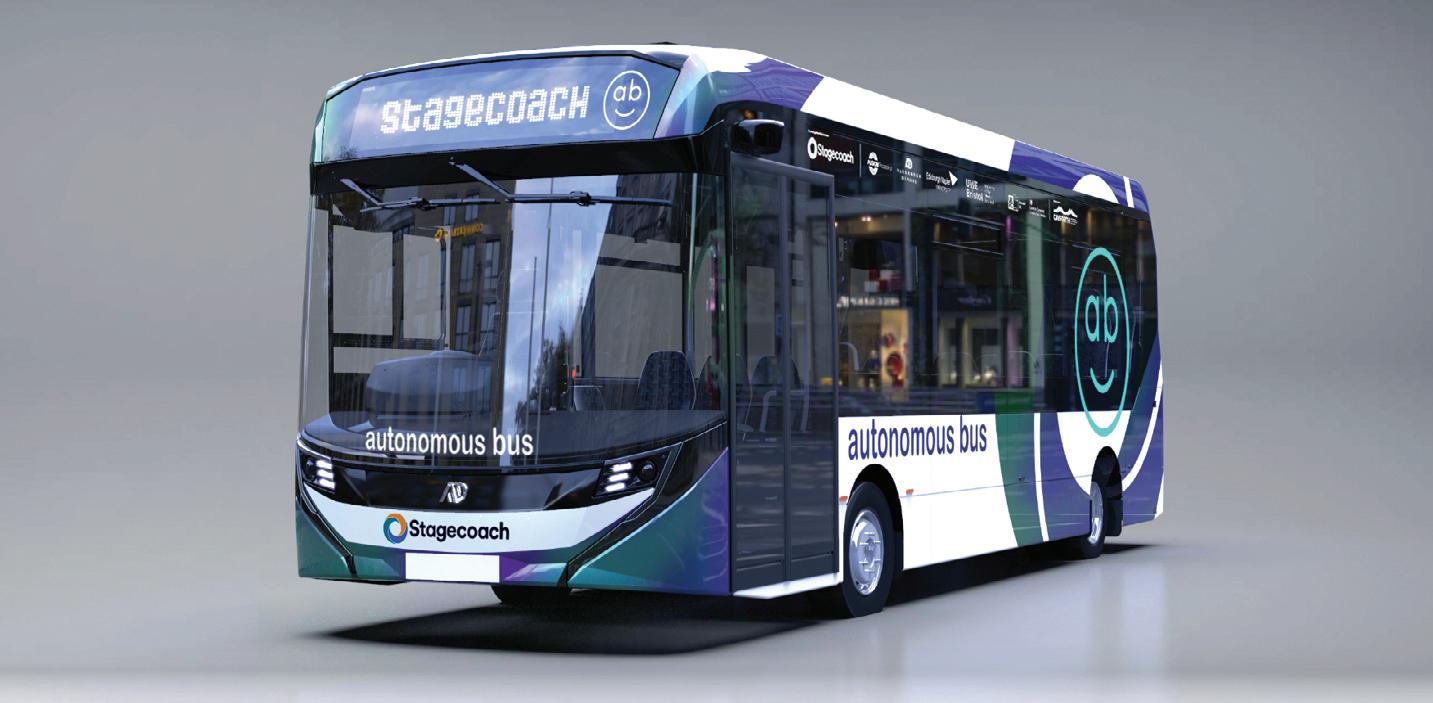
Passengers will be boarding the world’s first full-sized, self-driving bus service in Edinburgh from the Spring, after it was awarded a share of £81m in joint UK government and industry support for selfdriving transport technology.
The CAVForth II project is one of seven successful projects from around the UK, and forms the most advanced set of commercial, self-driving passenger and freight operations anywhere in the world.
The grants are part of the Centre for Connected and Autonomous Vehicles Connected and Automated Mobility programme. The scheme’s aim is to help British companies seize early opportunities to develop experimental projects into offerings ready for the market. Some £42m in government funding is being matched by industry. Industry consortia will match the public grant to around £81m and will be expected to demonstrate a sustainable commercial service by 2025.
The joint government and industry funding winners are:
• CAVForth II – Fusion Processing: £10.4m to launch an operational, fullsized, self-driving bus service in Edinburgh with Stagecoach and Alexander Dennis
• V-CAL: North East Automotive Alliance: £8m to roll out self-driving and remotely piloted HGVs between the Vantec and Nissan sites in Sunderland
• Hub2Hu – HVS: £13.2m to develop a new, zero emissions, self-driving HGV with Asda
• Sunderland Advanced Mobility Shuttle – City of Sunderland Council: £6m to build and trial a self-driving shuttle service to the University of Sunderland and the Sunderland Royal Hospital
• Project Harlander – Belfast Harbour: £11m to deploy a self-driving shuttle service around Belfast Harbour
• Multi-Area Connected Automated Mobility – Conigital: £15.2m to establish a remote driving control hub, to oversee self-driving vehicles operating in Solihull
and Coventry, with the NEC and local councils
• Project Cambridge Connector –Greater Cambridge Partnership: £17.4m to trial on-demand, self-driving taxis, to complement existing transport services in parts of Cambridge.
Almost £600,000 has also been awarded for feasibility studies, looking into how self-driving technology could improve public transport in four parts of the UK. These projects will look into potential routes where automated vehicles could operate exclusively from other traffic, to relieve congestion on the A414 through Hertfordshire and Essex, parts of Eastern Cambridge, Birmingham and Solihull, and Milton Keynes.
Bosch and APCOA Parking Group are planning to install automated valet parking technology across Germany. Last year the companies received approval for the commercial use of the system in the P6 parking garage at Stuttgart Airport. The partners now plan to expand the infrastructurebased, automated and driverless SAE Level 4 parking system at 15 sites.
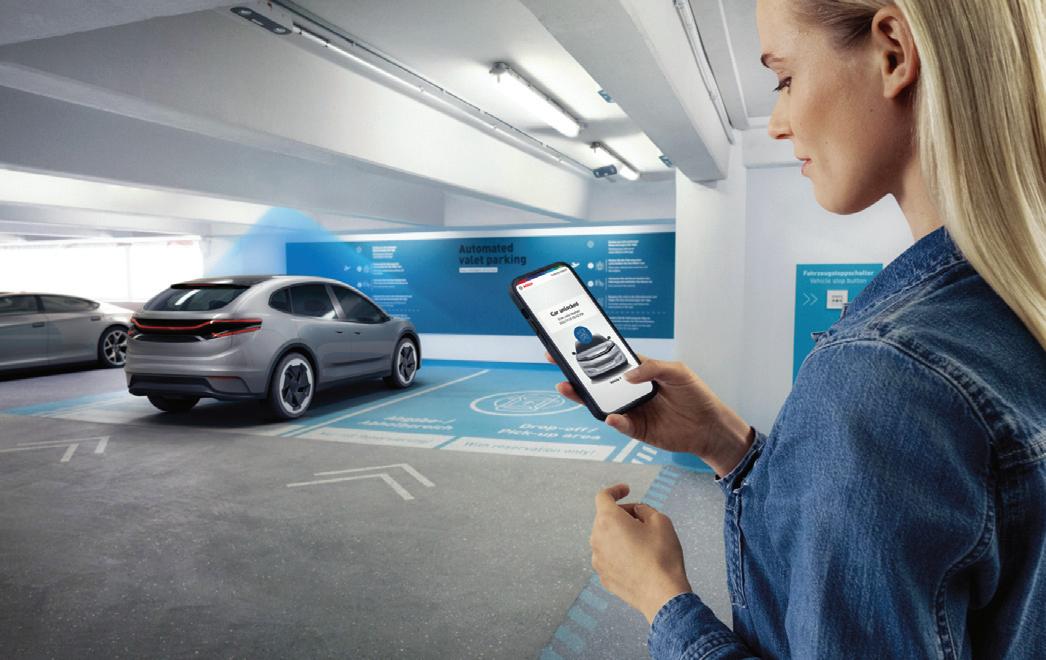
Automated valet parking will be available in selected parking garages in cities such as Berlin, Cologne, Frankfurt, Hamburg and Munich. Further car parks in Europe are set to follow. As a first step, Bosch and APCOA will make up to four parking spaces per parking garage ready for automated valet parking.
Automated valet parking involves a driver parking their self-driving capable vehicle in a handover zone near the entrance of a parking garage and using an app to start the automated and driverless parking service. The basis for this is Bosch
stereo cameras which not only identify vacant parking spaces but also monitor the driving aisle and its surroundings, and detect obstacles or people in the aisle.
If an unexpected obstacle is detected, the vehicle brakes and safely comes to a complete stop. Only
once the route is clear does it continue on its way. For this purpose, all the data generated by the cameras is fed into edge computers. Algorithms transmit the driving manouevre to be made and thus enable driverless parking – even when moving between storeys on
narrow ramps.
Bosch anticipates that its modular system will allow the number of parking spaces featuring the infrastructure technology to be quickly expanded to up to 200 parking bays at each of the 15 locations.
Dr Markus Heyn, member of the Bosch board of management and chairman of the mobility solutions business sector, said: “We will expand the number of such parking spaces based on the expected ramp-up of vehicles featuring automated valet parking. Our experience with charge spots for electric vehicles shows us how important it is for infrastructure growth to keep pace with the technology. Together with our partner APCOA, we are now making sure that this will be the case for automated valet parking.”
The master agreement signed by Bosch and APCOA is the first step toward a worldwide market launch. The companies’ goal is to equip several hundred parking garages across the globe with automated valet parking in the years ahead.
Compleo Charging Solutions UK, a provider of electric vehicle (EV) charging hardware and software solutions, has installed EV chargers for battery research organisation the Faraday Institution.
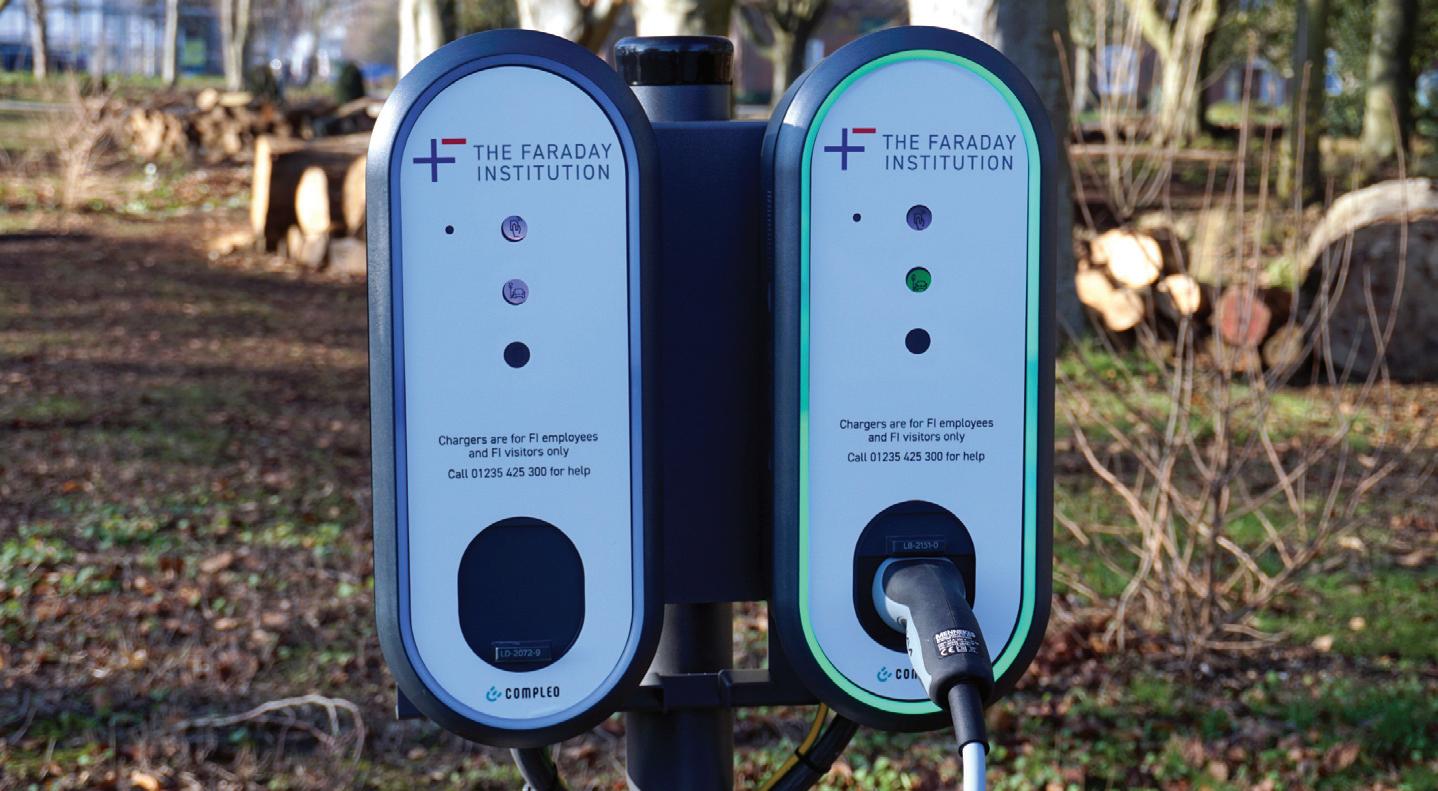
Compleo has installed fast-charging, 3 Phase 22kW AC units at the Faraday Institution’s designated parking spaces at the Harwell Science and Innovation Campus HQ in Oxfordshire.
The chargers will be for use by staff, its pool car and visitors.
The Faraday Institution is the UK’s independent institute for electrochemical energy storage research, skills development, market analysis and earlystage commercialisation.
Bringing together expertise from universities and industry, the Faraday Institution endeavours to make the UK the go-to place for the research and development of new electrical storage technologies for both the automotive and wider relevant sectors.
Susan Robertson, Faraday Institution’s chief operating officer, said: “The Compleo EV charging software (eOperate) is invaluable to us. It enables our staff,
visitors and pool cars to charge reliably using RFID cards while ensuring that speculative visitors to the site can’t plug in and get free electricity.
“A number of staff already own an electric vehicle and many of our employees have a long commute. Without reliable access to chargepoints when using their EV for work would be inconvenient for some. Providing the new charging infrastructure has been popular with staff, and doing so, has removed a barrier for the uptake of EVs for our employees –
Electric vehicle chargers have been installed across multiple sites owned by Kings College London.
EV charging specialist Mer won the contract to modernise the university college’s network of chargers. This included replacing older charging points with smart chargers, extending provision to new locations, networking all the chargers and providing a back-office system for monitoring and reporting.
Alexandra Hepple, sustainability officer at King’s College London said: “We have our own growing EV fleet and increasingly our contractors also
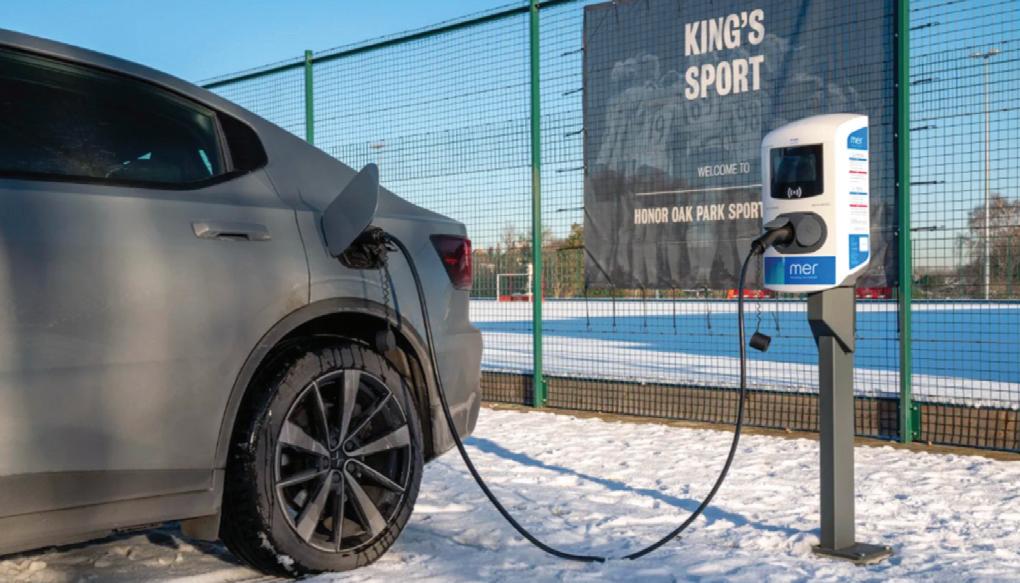
use electric vehicles, leading to higher demand for charging. Mer has done a fantastic job of creating a charging network that suits our needs today and also enables us to expand in years to come.”
Mer carried out site surveys across the King’s estate to identify utilisation rates of existing chargers. The team pinpointed the optimal locations for additional chargepoints such as the new sports centre at Honour Oak Park in South London. In total Mer installed 15 AC chargepoints across eight sites – a mixture of 7kW and 22kW fast chargers.
important for us as the UK’s independent institute for battery energy storage research.”
Valentin Scheltow, Compleo UK’s chief executive, said: “We’re really proud to have our head office in Oxfordshire and working with other local businesses, especially one as renowned as the Faraday Institution, is a privilege for us at Compleo. Our mission is to help make e-mobility and electric vehicle charging available for everyone when they park at home, work and leisure.”
Liverpool City Council has appointed Ubitricity to install a network of 300 on-street electric vehicle chargepoints, with the locations chosen by residents and businesses.
The additional chargepoints are set to treble Liverpool City Council’s existing network of 150 charge points to 450. This would make Liverpool the authority with the third largest public charging network in the UK, behind London and Coventry.
The roll-out comes as part of a twopart project, which will see Ubitricity take over the repair of Liverpool’s existing charging infrastructure and then rollout more chargepoints to help enable residents to make the switch to electric vehicles.
The new chargepoints, which are installed directly into existing street lamp columns, charge at a speed of up to 5kW and take just under two hours to install.
The roll-out is planned for key residential and commercial locations, allowing residents to easily charge pure-electric and plug-in hybrid vehicles on the street where they live. Liverpool City Council is looking to address disparity in EV adoption and take a major step
towards achieving its carbon net zero target by 2030. Liverpool’s goal is to make EV charging accessible for everyone, with a particular focus on residents who do not have access to private off-street parking and charging. The roll-out is led by community requests, with the Liverpool City Council receiving more than 10 requests a week for new public chargepoints.
After Liverpool City Council declared a climate emergency in 2019, it unveiled its 2030 Net Zero Liverpool Action Plan which laid out a roadmap to tackle its carbon footprint. One of the key aims of this plan, which also includes developing the city’s cycling and walking infrastructure, was to reduce carbon from transport in Liverpool.
Cllr Dan Barrington, cabinet member for climate change and highways for Liverpool City Council. “ The fact that the roll-out is being led by community requests means the points are going where the demand is needed most which means they’ll be getting maximum usage. Hopefully demand will grow meaning more charging points need to be installed.”
McArthurGlen has expanded its EV charging portfolio by installing charging points at its East Midlands Designer Outlet. The designer outlet group has partnered with RAW Charging to install accessible and reliable charging infrastructure at the shopping destination.

EV drivers can now opt to charge their vehicles whilst shopping and enjoying a day out at the outlet, which has 65 designer stores and various eateries.
Located just one minute off the M1, near the intersection of the A38 motorway, local drivers are being encouraged to make the outlet their go-to charging destination whilst away from home.
Nine dual fast chargers have been installed which will allow 18 vehicles to charge simultaneously. The East Midlands Designer Outlet is the first commercial site in the UK to have CP6000 units installed. The new charging points will help meet the growing demand among EV drivers for destination charging – with an estimated 45% of motorists relying on charging facilities away from home.
RAW Charging has installed four socketed AC units and five cable-attached AC units to cater for all EV types. Drivers
are given the option to pay to charge through a mobile app, via a contactless credit or debit card or by an RFID card. The McArthurGlen Group currently operates seven designer outlets across the UK. Last year RAW Charging agreed a partnership with the group to provide EV charging infrastructure across its portfolio to promote sustainable travel to their outlets. Through the partnership, RAW Charging fund, install and maintain operations of all electric charging points to offer McArthurGlen a long-term
revenue stream and cater to the charging needs of visitors to its designer outlets. Paul Sutton, centre manager at East Midlands Designer Outlet, said: “As part of our on-going modernisation works, we are delighted to announce the installation of RAW Charging electric vehicle facilities at the centre. The addition of this charging infrastructure sees East Midlands Designer Outlet become one of the largest EV charging hubs in the area, and the largest charging hub in the McArthurGlen’s UK portfolio.”
Chargepoint operator Liberty Charge has made three director level appointments. Matt Croucher joins in the newly created role of EV services director, Amanda Pun in another new role as legal director, and Perran Moon as chief marketing officer.


Chargers at Pease Pottage
Gridserve says it has electrified the route from London to Brighton with a new Electric Super Hub. The route will now be easier EV drivers looking to visit seaside destinations such as Brighton, Bognor Regis, Worthing and Newhaven this summer.
Located at the Pease Pottage Moto services on the M23, the hub features six 350kW-capable High Power charging units that can add 100 miles of range in less than 10 minutes. The site can accommodate six more in the future.
Pease Pottage is Gridserve’s 13th Electric Super Hub and second this year, following the opening of Solstice Park, near Stonehenge.
The Electric Super Hub features both CCS connectors and CHAdeMO connectors (which cannot dual charge). There are also two Medium Power Gridserve chargers up to 60kW with four connectors (three CCS and one CHAdeMO) and one AC Gridserve charger up to 22kW.
Pease Pottage offers contactless payment.
Croucher brings extensive experience in planning, including as the zero-emission mobility lead at WSP. His experience in the EV sector stretches back to the industry’s early years in 2009, across a range of projects within the public and private sectors. Croucher said: “My primary focus is to grow the number of chargepoints through collaborating with local authorities, working closely with all stakeholders to understand their needs and the best solutions.”
Amanda Pun has experience in the telecommunications industry. She said: “It’s an exciting time for the industry as it accelerates at pace to keep up with growing EV ownership. From a legal perspective, this provides a great opportunity to start from the ground up. It means collaborating closely with councils and industry to establish required outcomes, and doing so in the
simplest ways possible.”
With more than 25 years’ experience in the automotive industry, Perran Moon said: “Clear communication, in addition to an offering that removes all hassle associated with the funding, logistics and maintenance of EV chargepoints, will be vital in supporting local authorities to provide infrastructure that works for residents and local authorities, and not against them.”
Mercedes-Benz plans to launch a network of high-power EV chargers across North America, Europe, China and other key markets. It will begin to be built this year in the US and Canada, followed by other regions around the globe.
The German car maker’s aim is to have the full network in place before the end of the decade, when Mercedes-Benz intends to go all-electric wherever market conditions allow.
The Mercedes-Benz charging hubs will be located in key cities and urban population centres, close to major arteries, convenient retail and service destinations, including participating Mercedes-Benz dealership sites.
The company believes this strategic move will significantly enhance the usability and convenience of its new generation of electric vehicles, differentiate the Mercedes-Benz ownership experience and accelerate the EV transformation.
The charging network will focus first and foremost on Mercedes-Benz customers, who will enjoy preferential access via a reservation function and other benefits. However, it will also be open to drivers of all other brands with compatible technology. The initiative, alongside ongoing support for shared networks such as IONITY, also aims to drive global adoption of electric mobility.
At the CES 2023 show in Las Vegas, Mercedes-Benz announced that the roll-
out of its high-power charging network will start this year in North America. The collaboration partners here include MN8 Energy, one of the largest solar energy and battery storage owners and operators in the US, and ChargePoint, an EV charging network technology company. By 2027, a network totalling more than 400 hubs across North America with more than 2,500 high-power chargers is planned to offer a premium, sustainable and reliable charging experience.
Ola Källenius, chairman of the board of management of Mercedes-Benz Group, said: “Mercedes-Benz already offers what we believe to be the finest EVs in the market. But to accelerate the electric transformation, we need to ensure that the charging experience keeps pace as well. Our customers deserve a compelling charging experience that makes electric vehicle ownership and long-distance travel effortless.
“We won’t take a wait-and-see approach for this to be built. That’s why we are launching a global high-end charging network. It’s designed to become another differentiator of Mercedes-Benz ownership for our customers and an asset with value creation potential for our company. We are excited to start right here in North America with strong and experienced partners like MN8 Energy and ChargePoint.”
For those travelling long distances, Mercedes-Benz Electric Intelligence navigation makes life easy by automatically optimising route planning, incorporating the best charging points and reserving spaces in advance. The
system knows the capacity utilisation at the respective locations and ensures customers can gain immediate access to the reserved charging point at the required time. Mercedes-Benz is promising an easy and convenient “Plug & Charge” function.
The charging station communicates directly with the vehicle via the charging cable. Manual authentication via card, app or head unit will not be required but possible. Mercedes-Benz customers can use this function via a Mercedes me connect service called Mercedes me Charge. All other customers will have straightforward access to a wide array of payment functions.
Depending on region and location, the hubs will offer four to 12, and ultimately as many as 30, high-power chargers (HPC) with up to 350 kW of charging power. Intelligent charge-load management will allow each vehicle to charge at its maximum capacity keeping waiting times to an absolute minimum. The optimised station layout will ensure plenty of space around the vehicle as well as unhindered charging from either side. Where feasible, charging points will be covered for protection from the weather.
The locations and surroundings of the Mercedes-Benz charging hubs will be carefully selected with wider customer needs in mind. The best possible charging experience will therefore come with food outlets and restrooms situated nearby. Facilities will also be equipped with surveillance cameras and other measures to provide a safe and secure charging environment.

YOUR GUIDE TO CONSTRUCTION, CONSULTANCY, PARKING SYSTEMS, TECHNOLOGY AND RECRUITMENT SERVICES
The Leading Independent Consultancy for all your parking solu琀ons
Established in 1991, with over 230 sa琀s昀ed customers comprising both public and private sector (including Local Authority and Health and Educa琀on establishments). Quality parking solu琀ons provided by our experienced in house specialists:
GIS mapping and surveying
• MTO site surveys and digi琀sing.
• On street TRO signs and lines: legality and condi琀on surveys (sample surveys also available).
• GIS mapping of TRO surveys, produc琀on of digital maps and TRO management for Order wri琀ng, upda琀ng and consolida琀on.
• Data extrac琀on and conversion of text based schedules to digi琀sed map based solu琀ons.
• Length of stay, usage, and occupancy parking surveys, both on and o昀 street.

• Compliance surveys and data analysis.
• Surveying and mapping of infrastructure assets.
Contact:
Consultancy services
• Financial appraisal and e�ciency reviews of parking service provision.



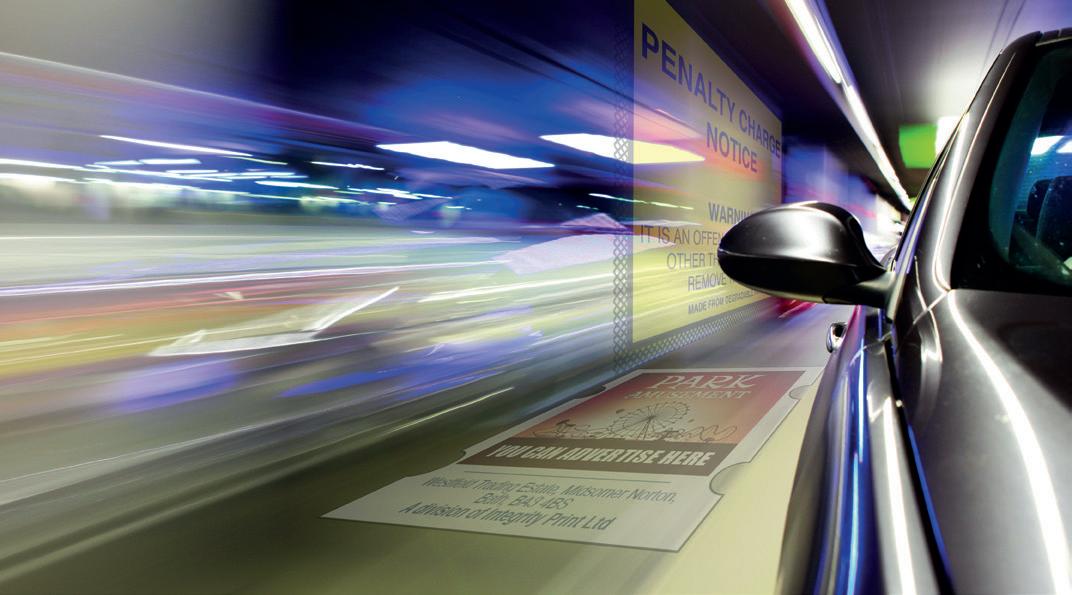
• Collabora琀ve working – joint no琀ce processing and shared enforcement.
• On and O昀 street tra�c regula琀on order wri琀ng.
• DPE and CPE feasibility studies and implementa琀on.
• Tari昀 reviews.
• DPE/CPE services speci昀ca琀on wri琀ng and tender evalua琀on.

Peter Lowe B.Eng., C.Eng., M.I.C.E., FBPA
Tel: 01492585055 or 07900264137
Email: plowe@rtaassociates.co.uk
RTA Associates Ltd www.rtaassociates.co.uk
ENFORCEMENT & DEBT RECOVERY SERVICES
For more information on our services, please contact:
Lauren Appleby (North) lappleby@newlynplc.co.uk 07931 811088
Shaun Byrne (South) sbyrne@newlynplc.co.uk 07964 764099

DOCUMENT AND STATIONARY SERVICES
www.parkingandsecuredocuments.com
Email:
PSD - incorporating The Parking Shop –is the market leader for parking related statutory document mailings and sustainable manual enforcement stationery.
We also supply line marking and signage solutions and as part of our service we offer on site surveys and reports.






















































































































